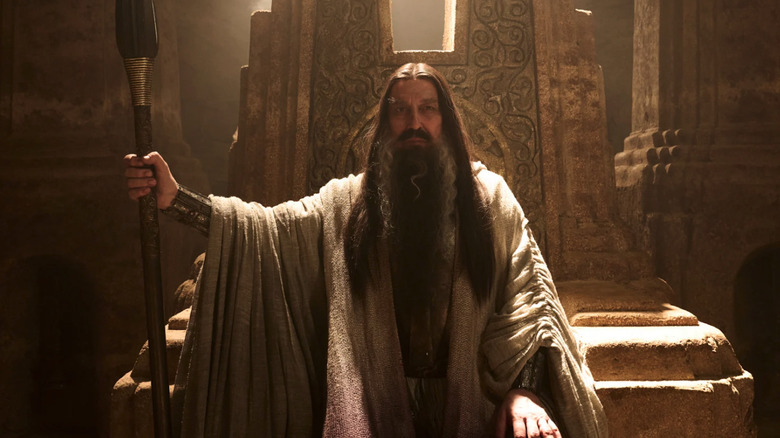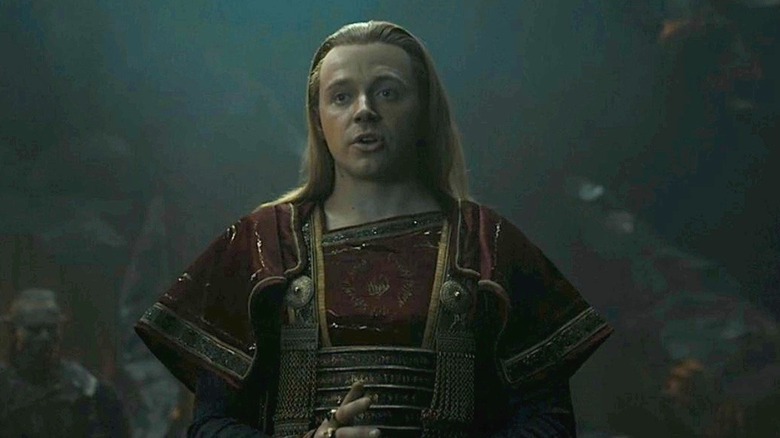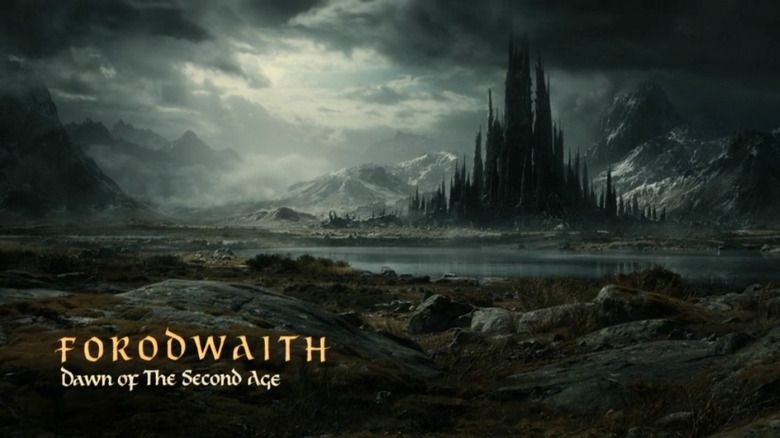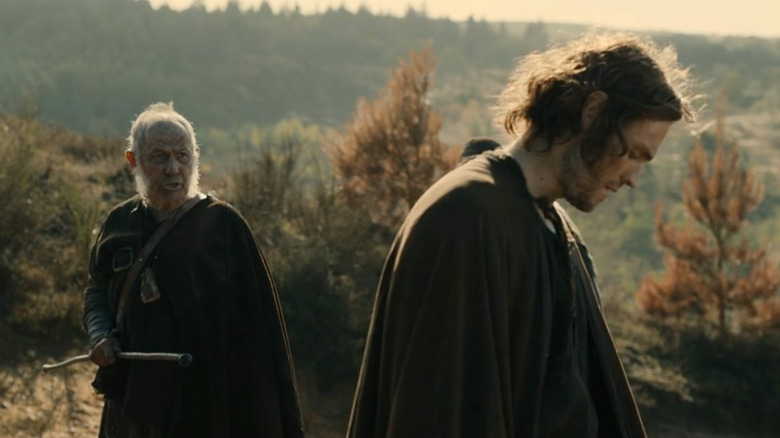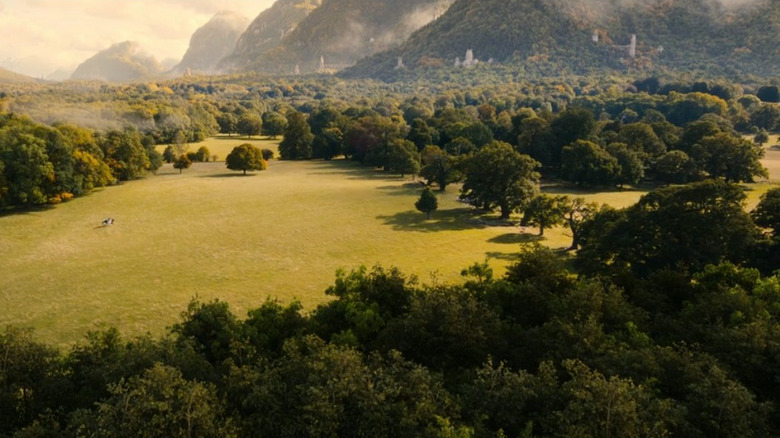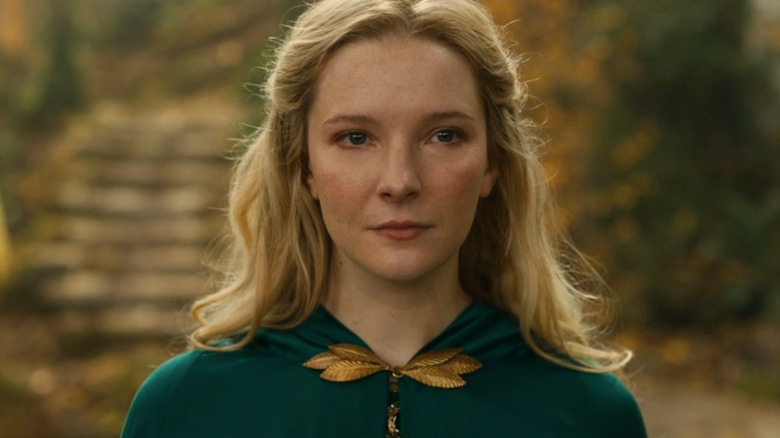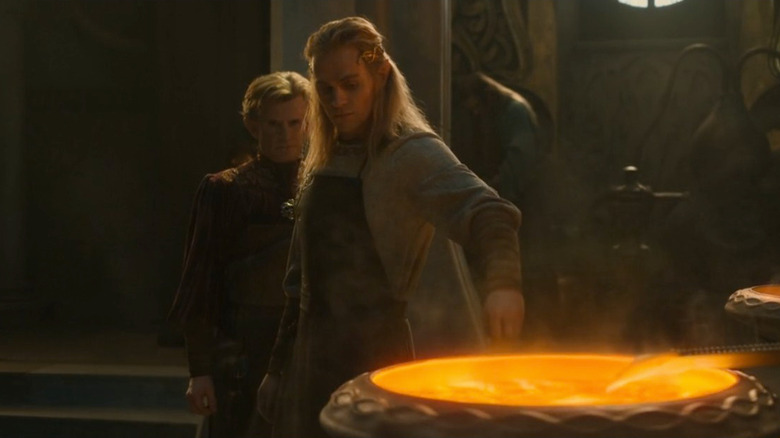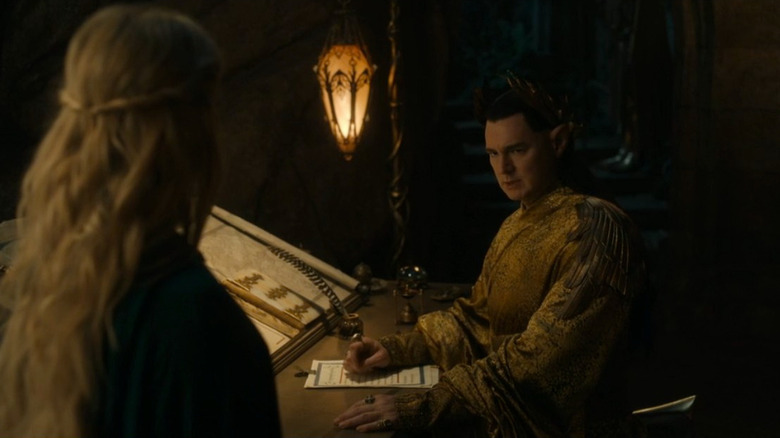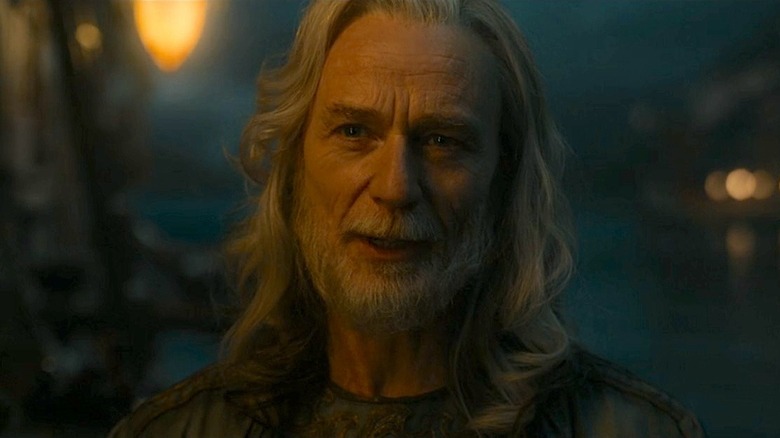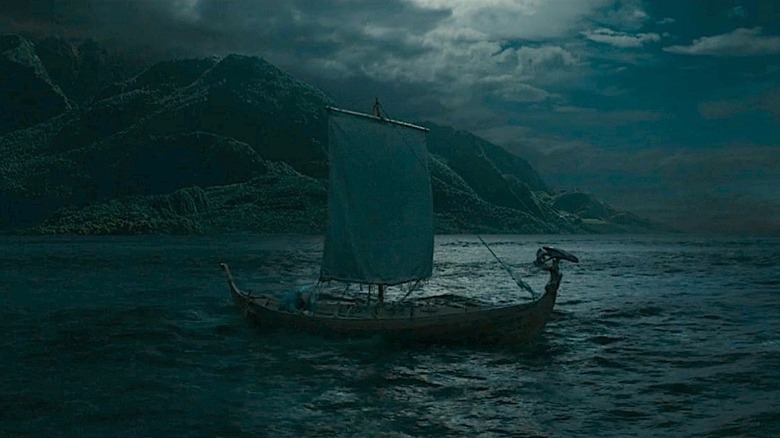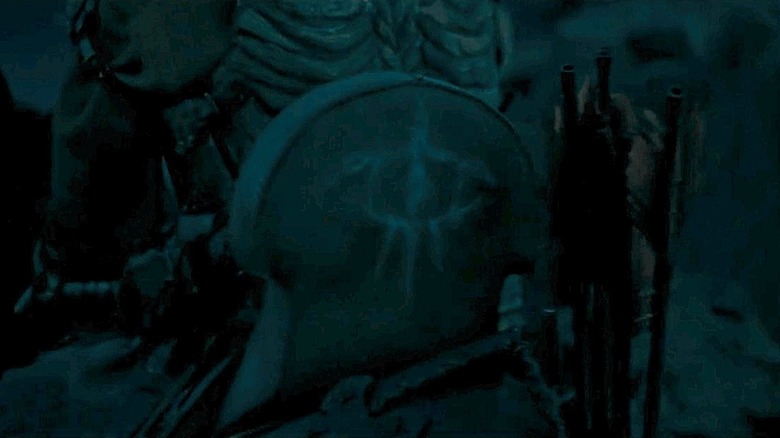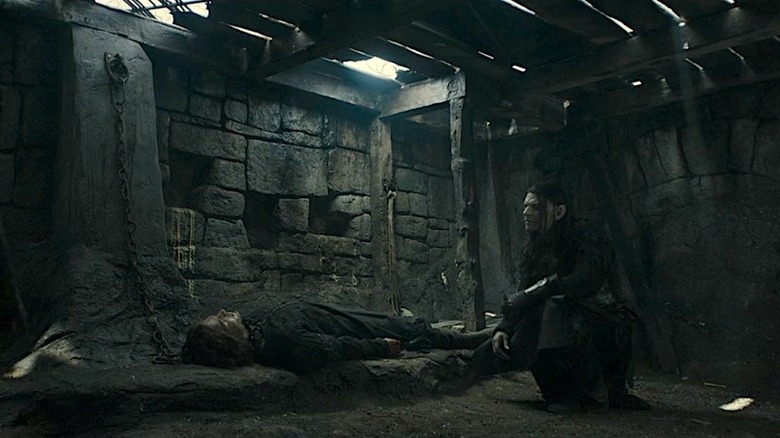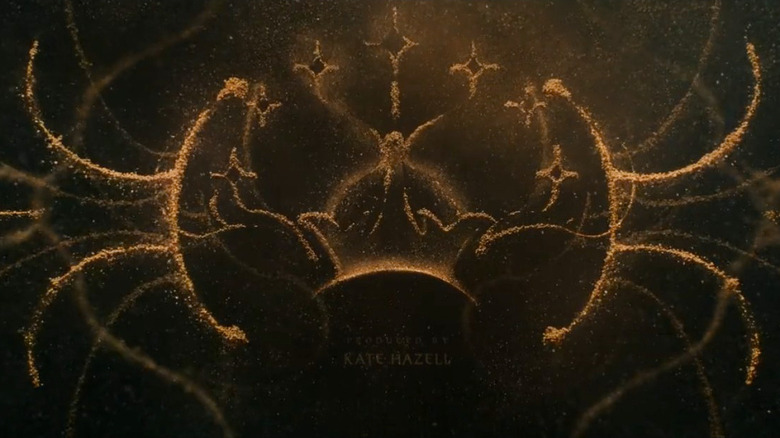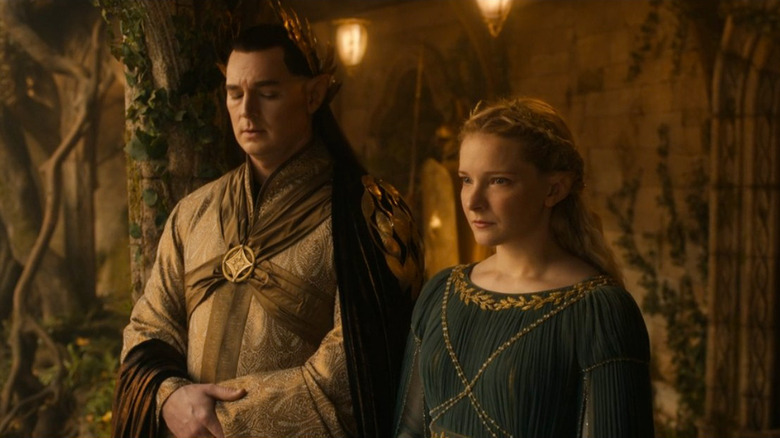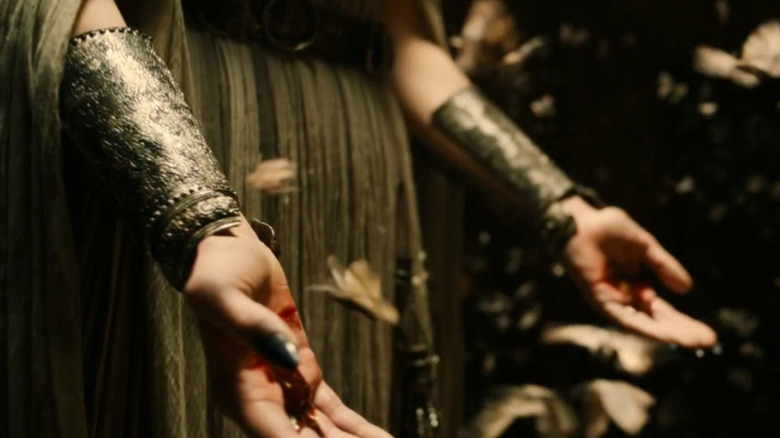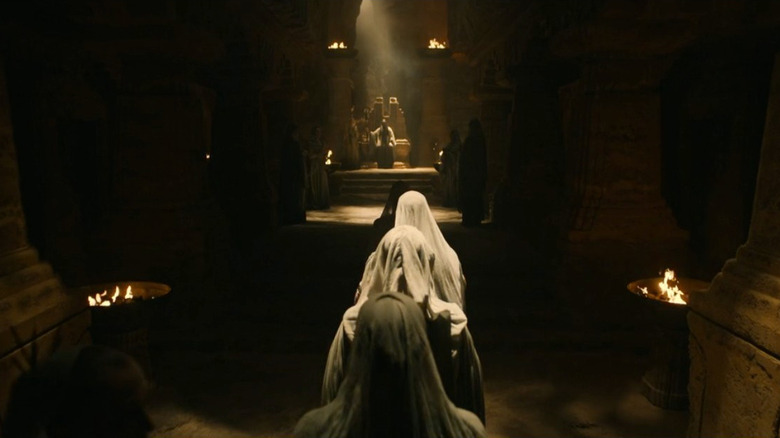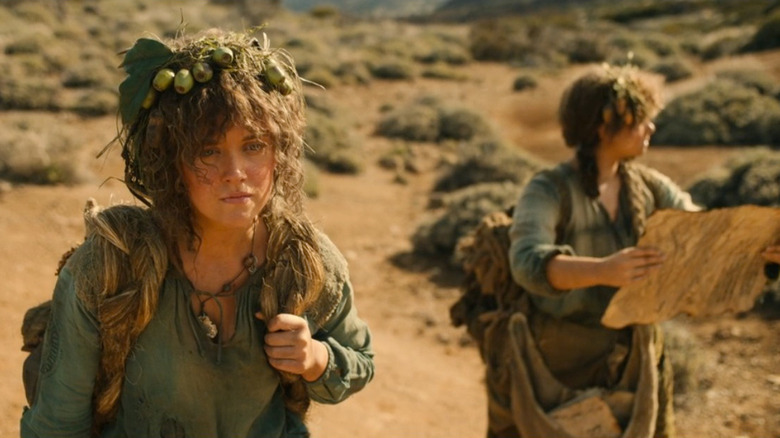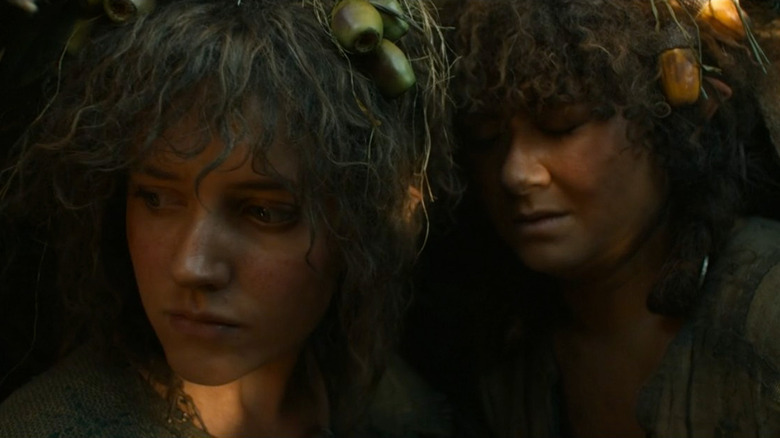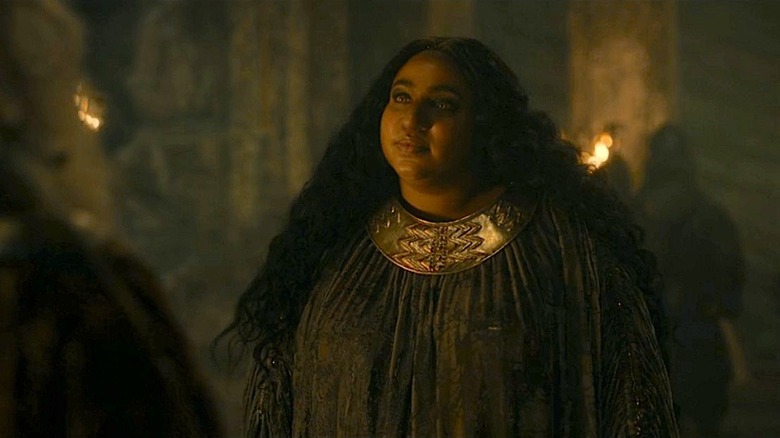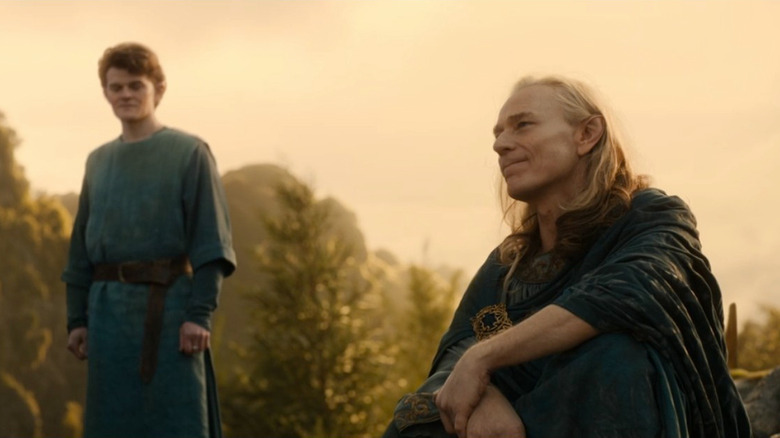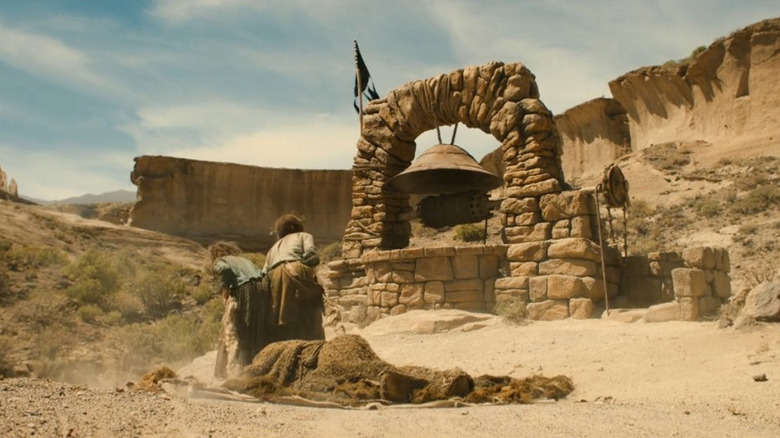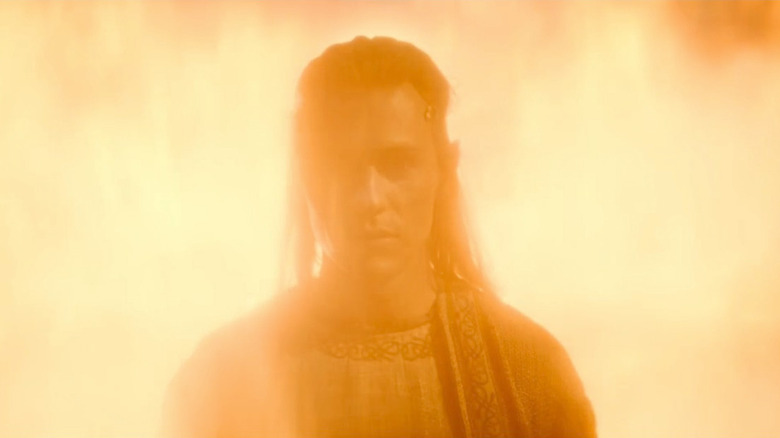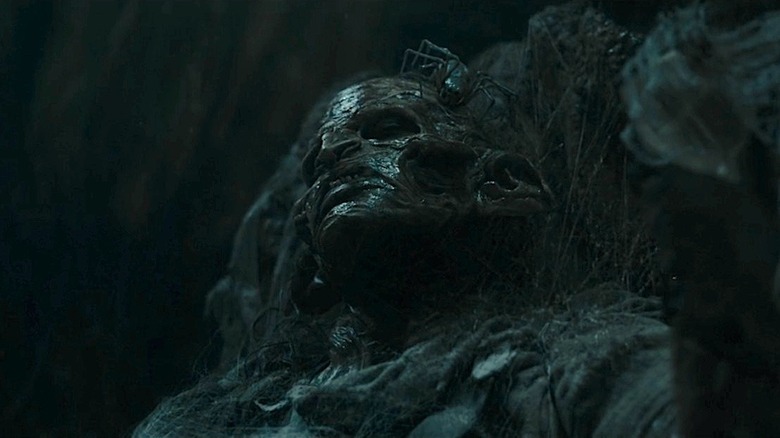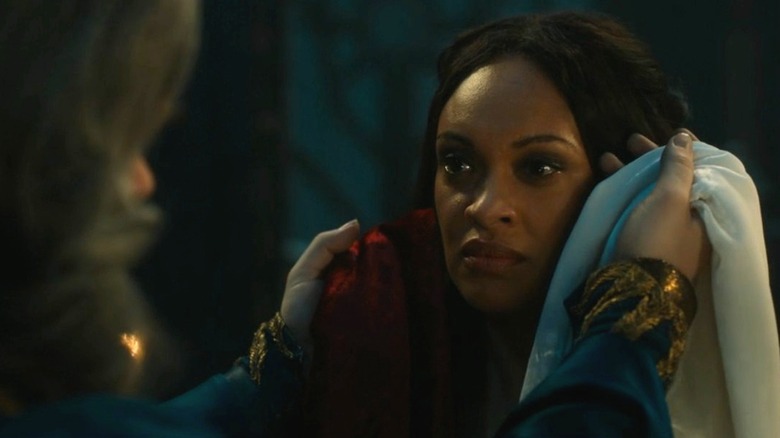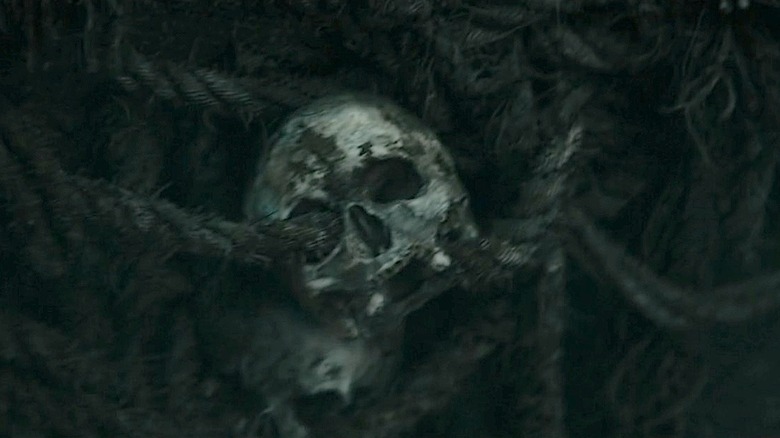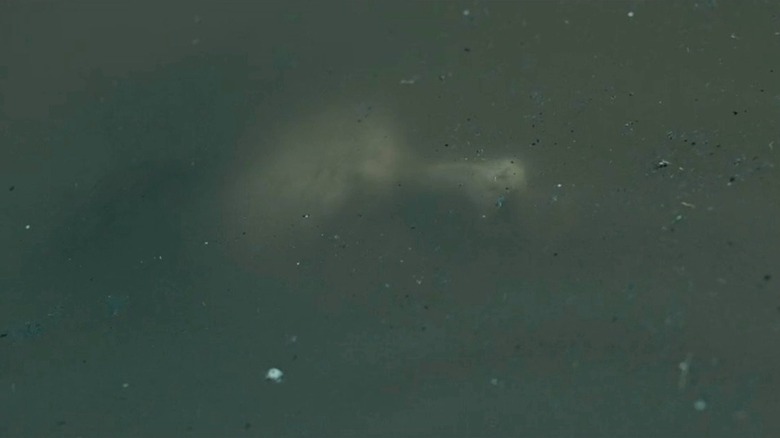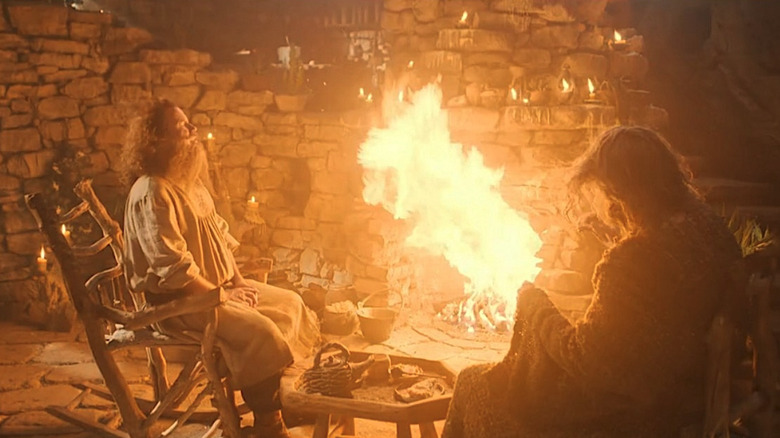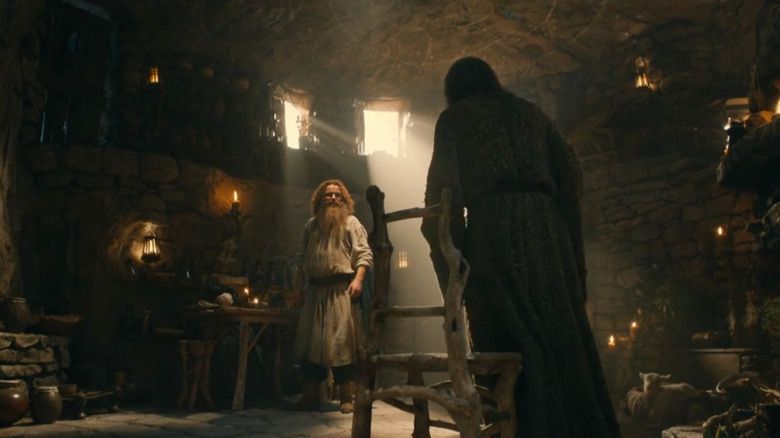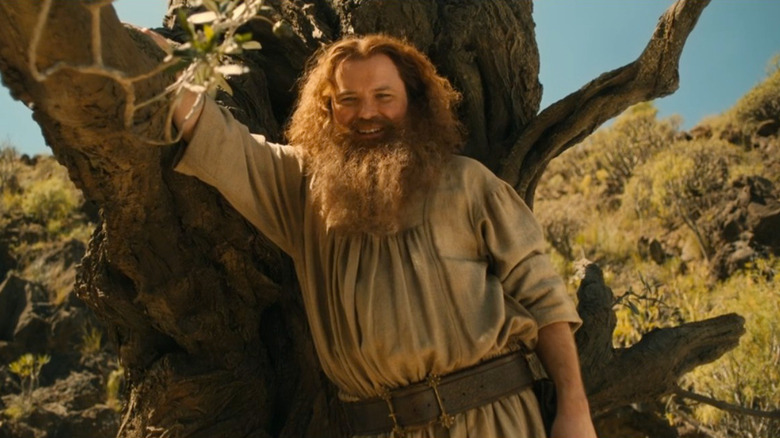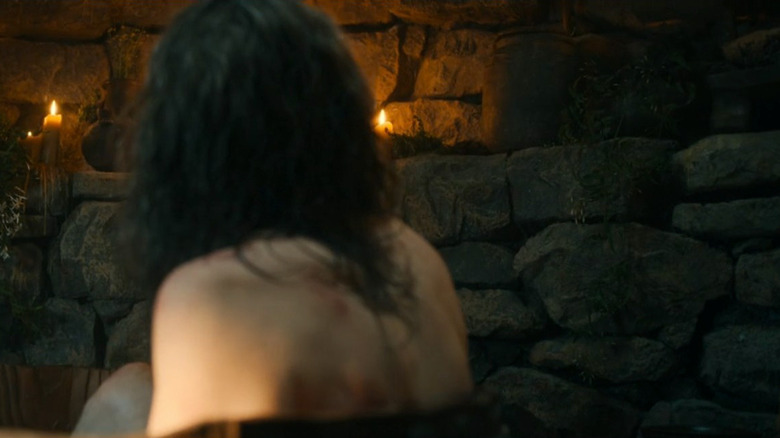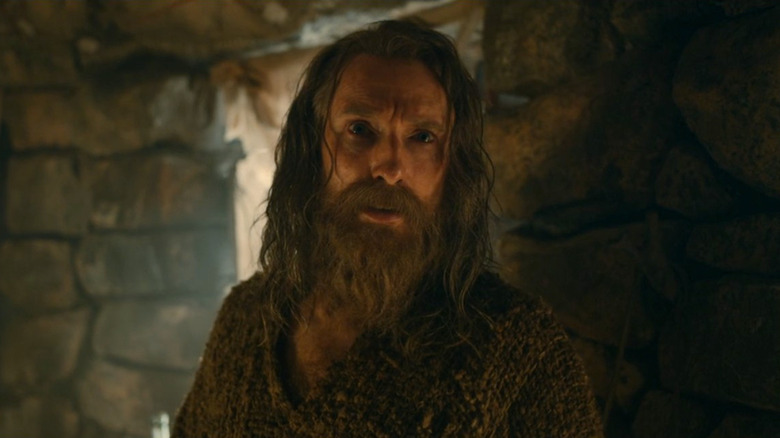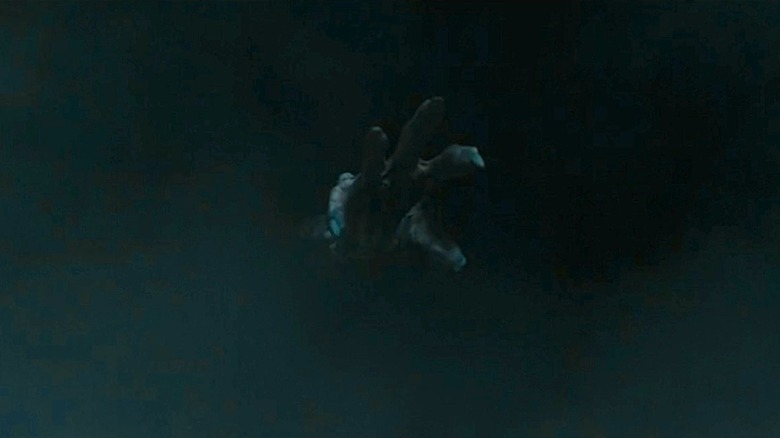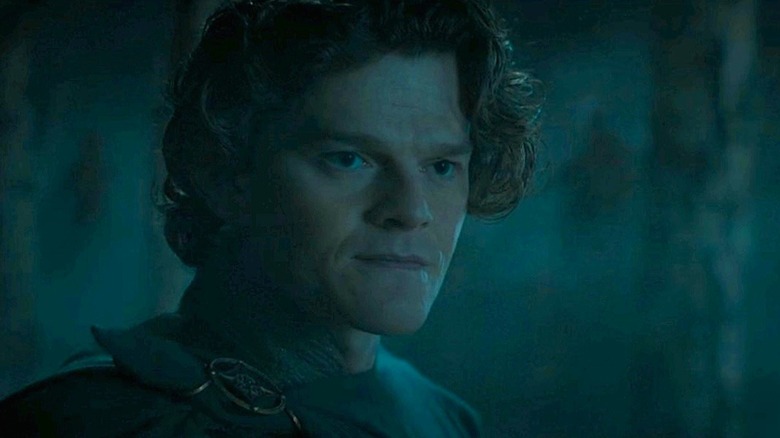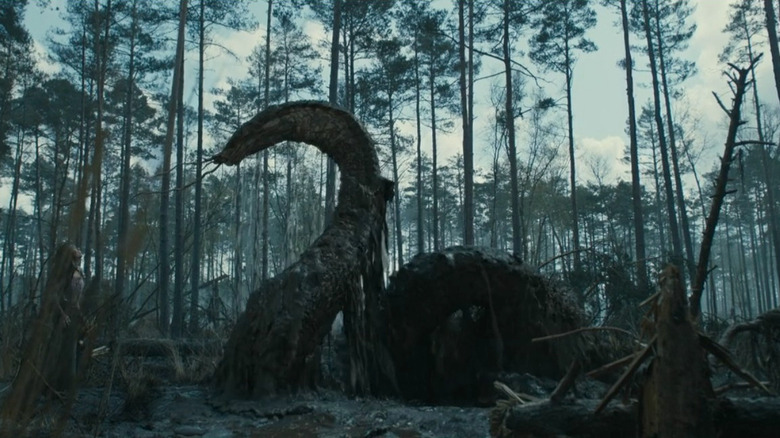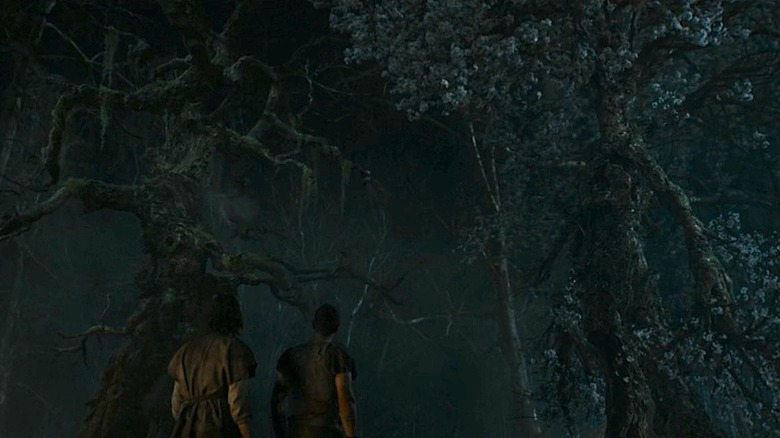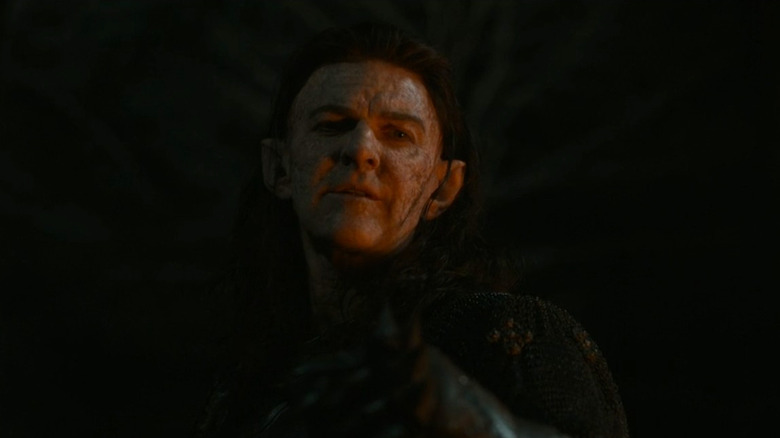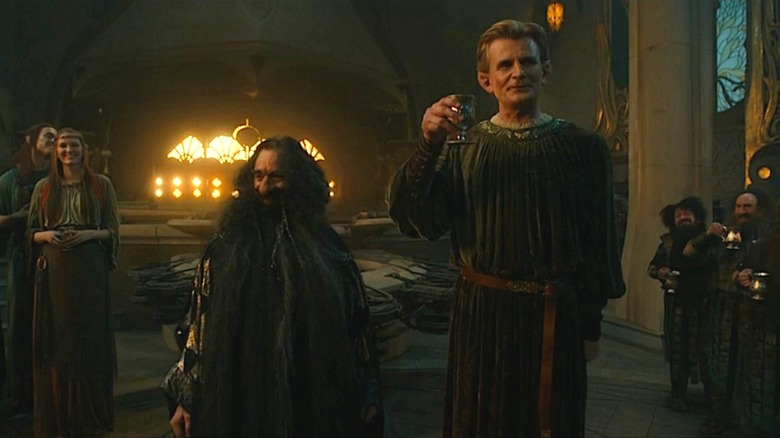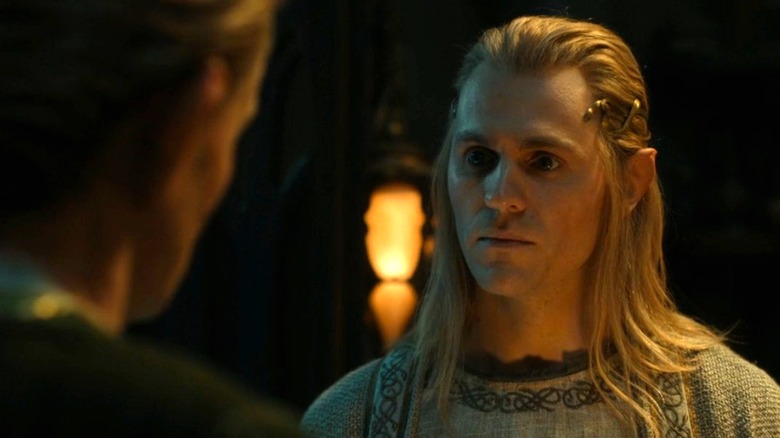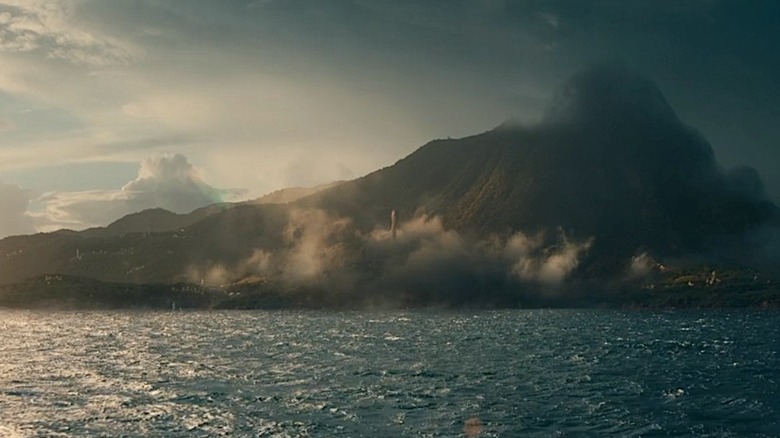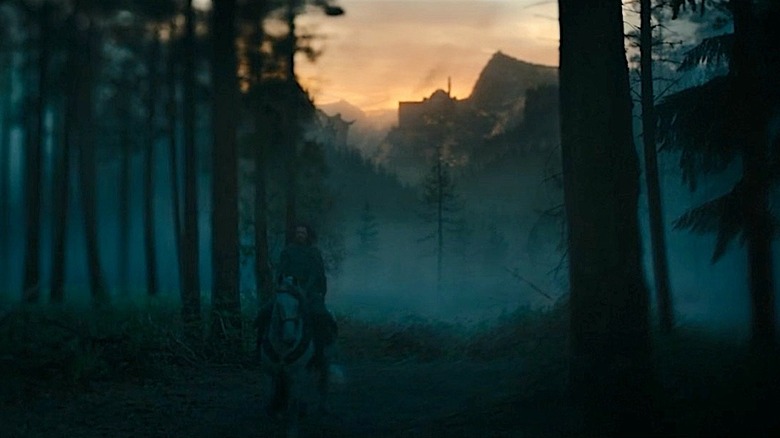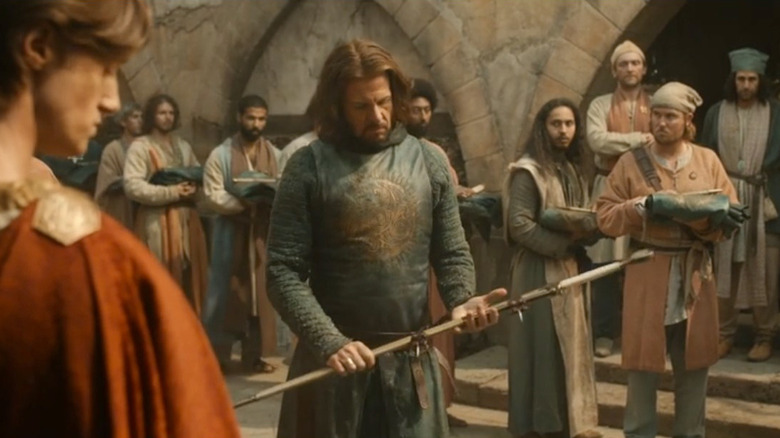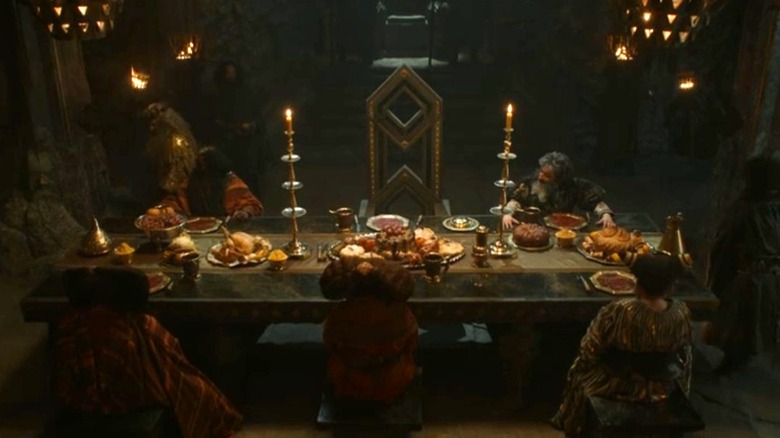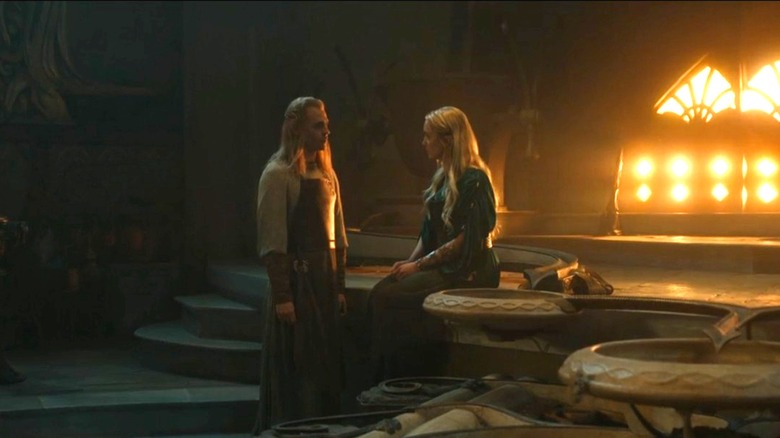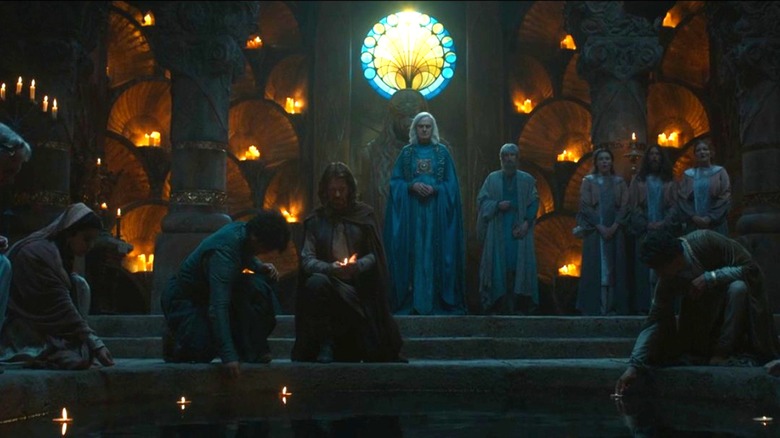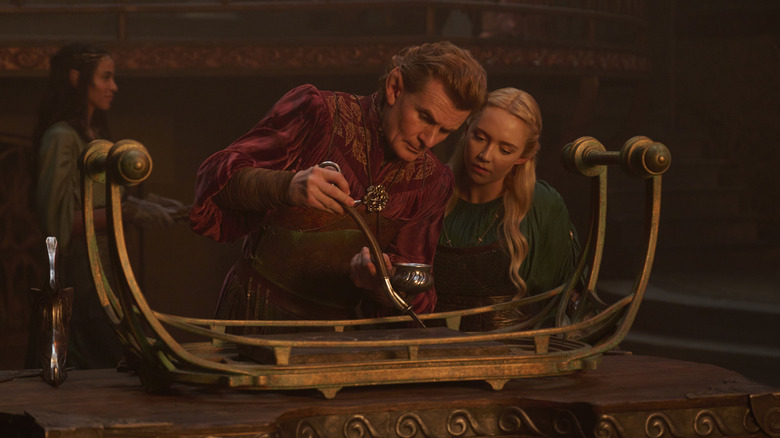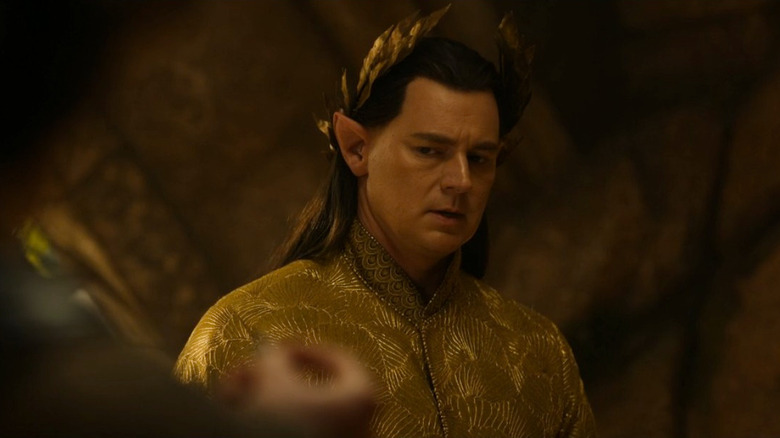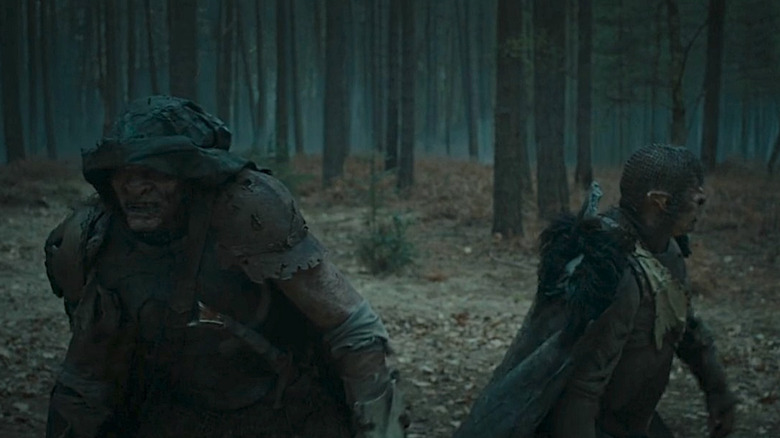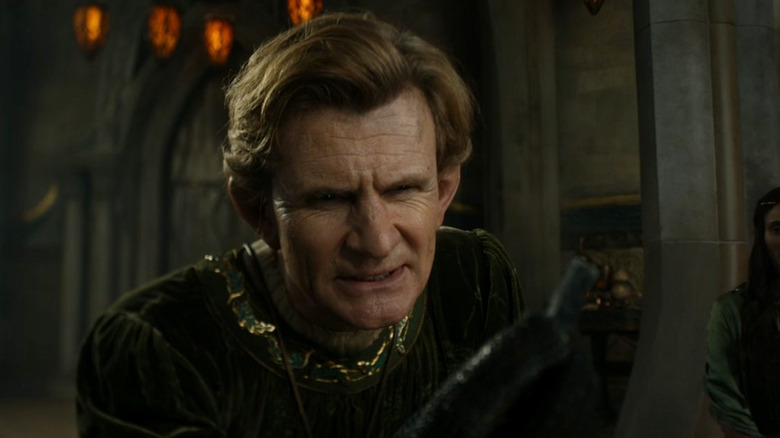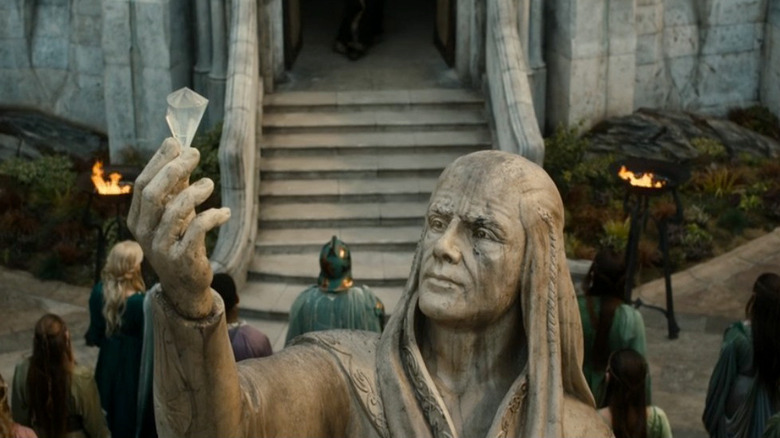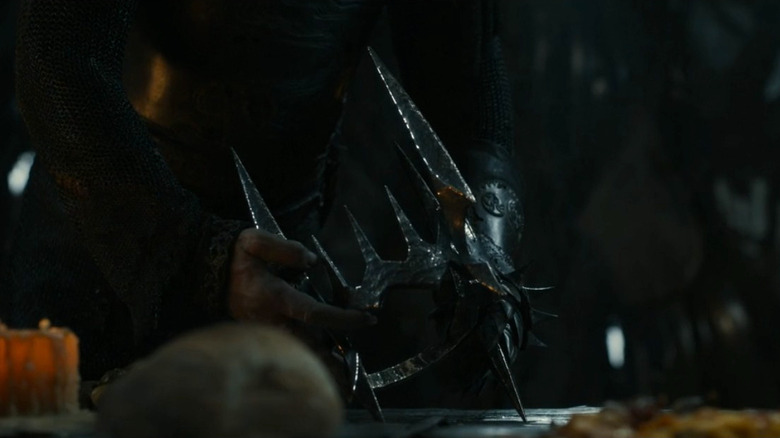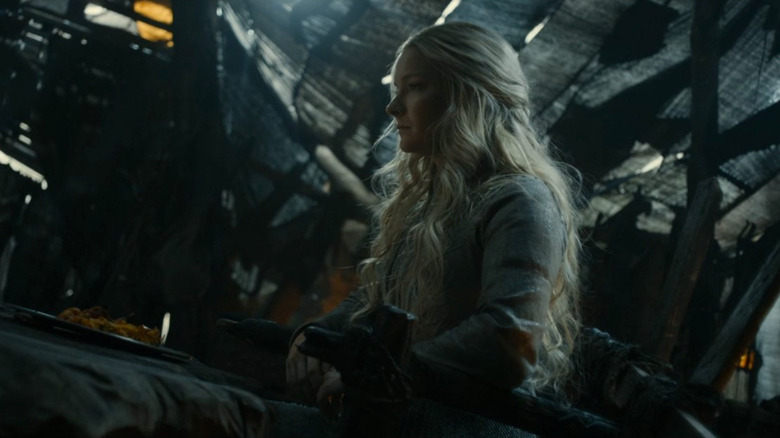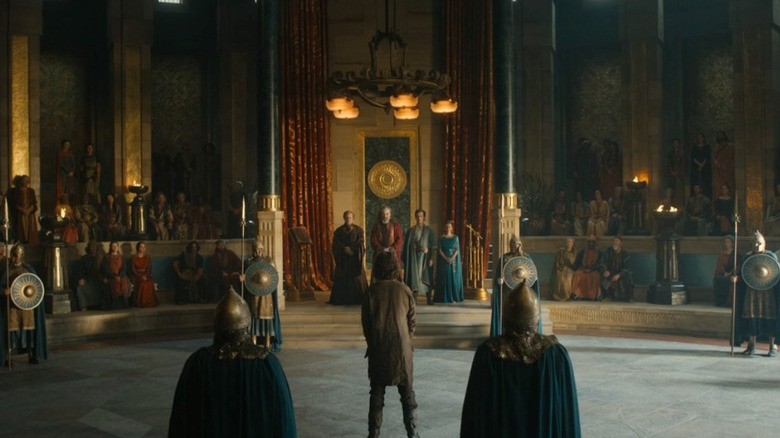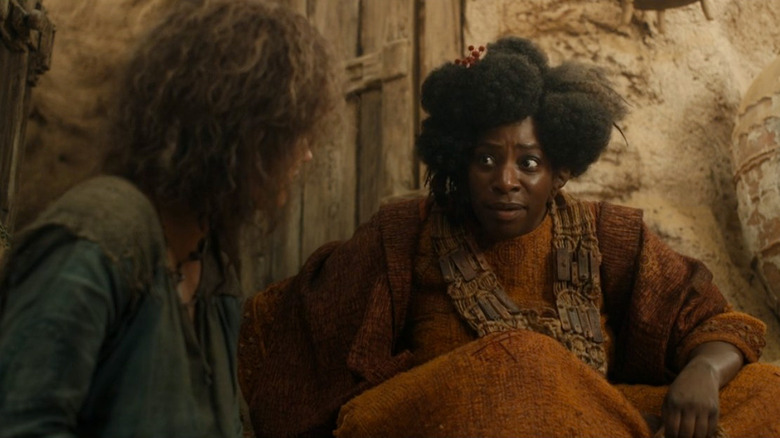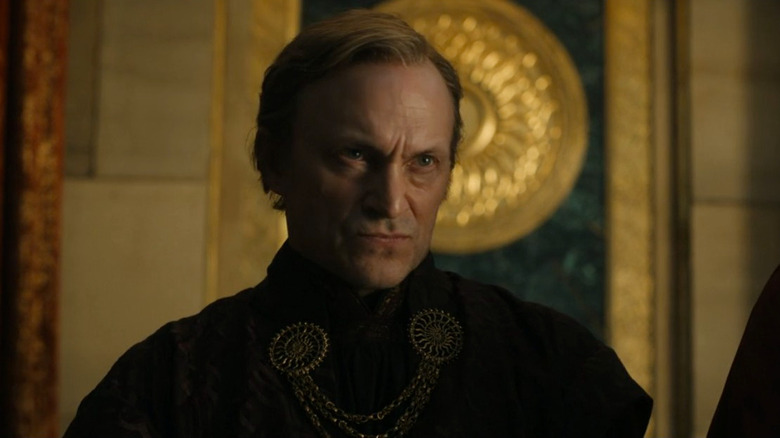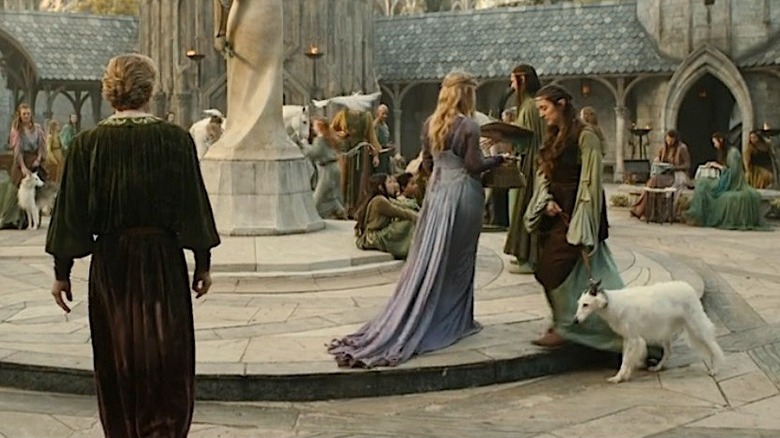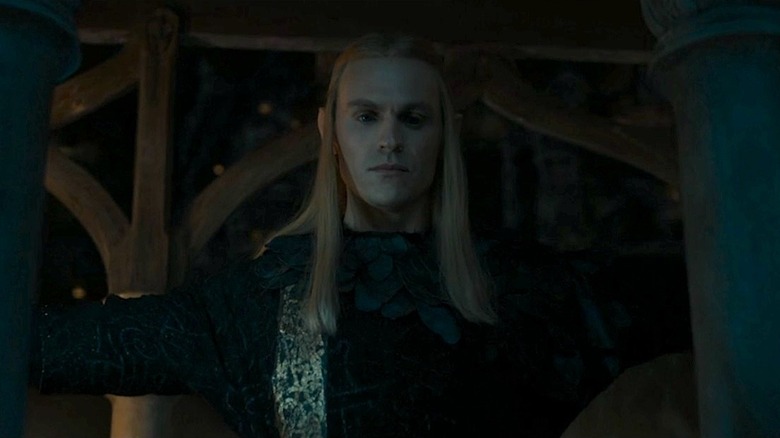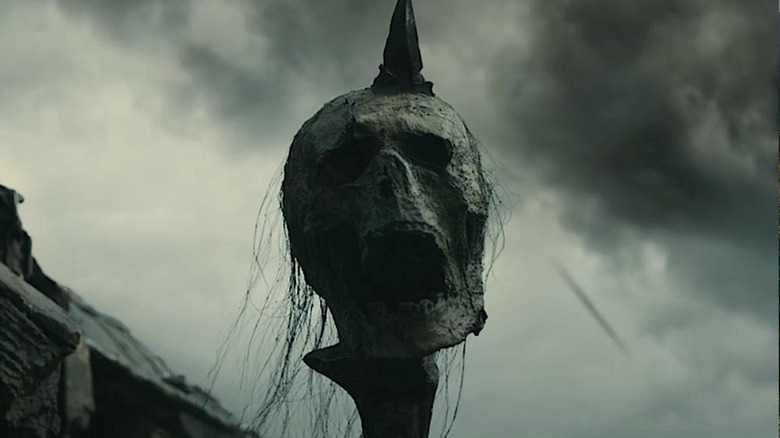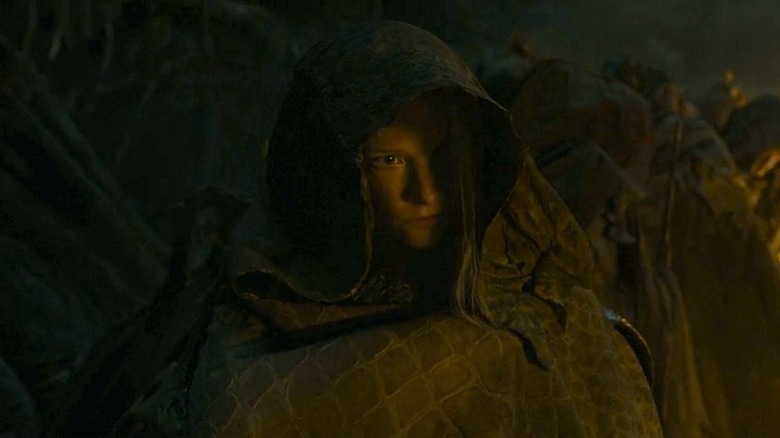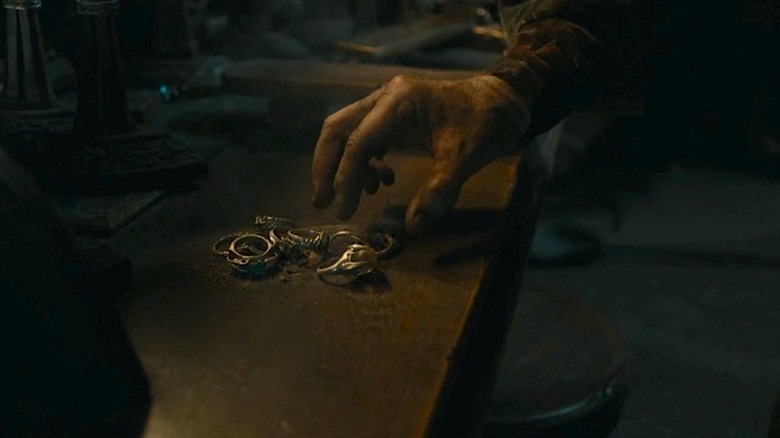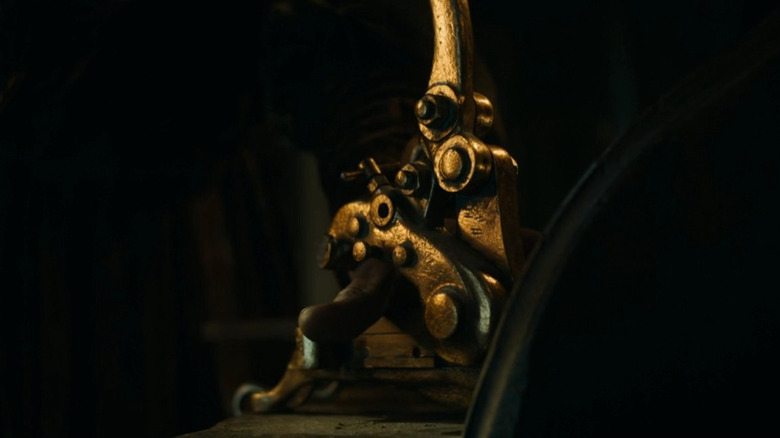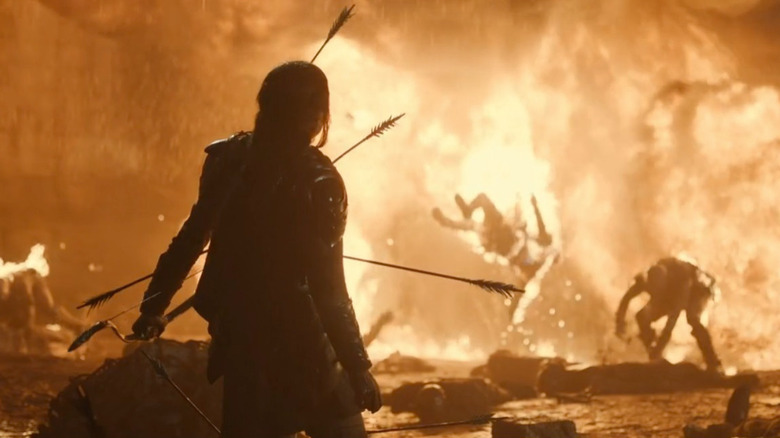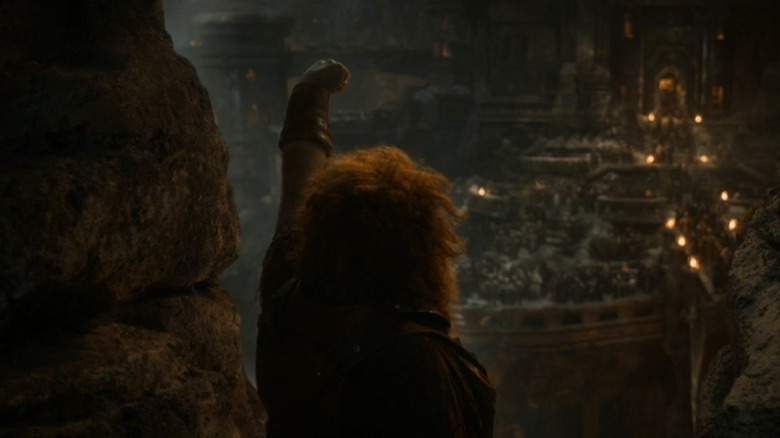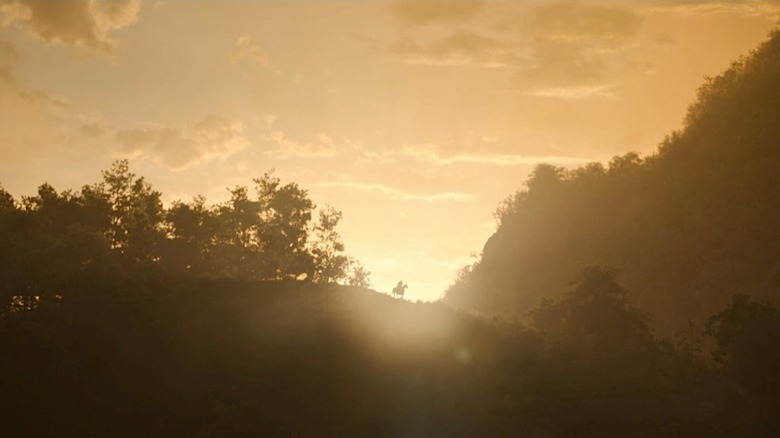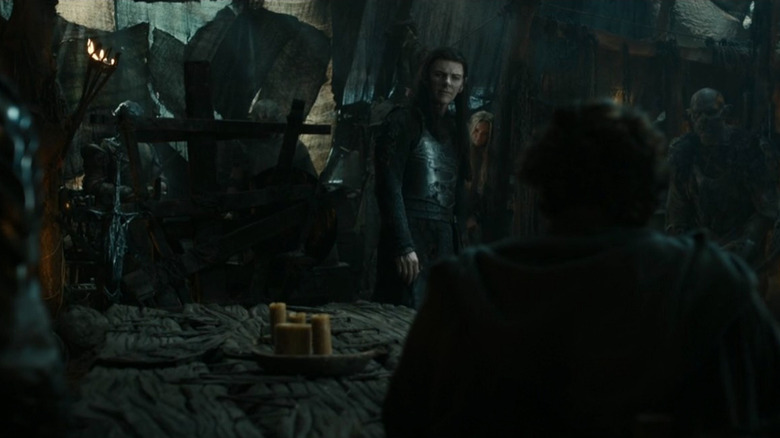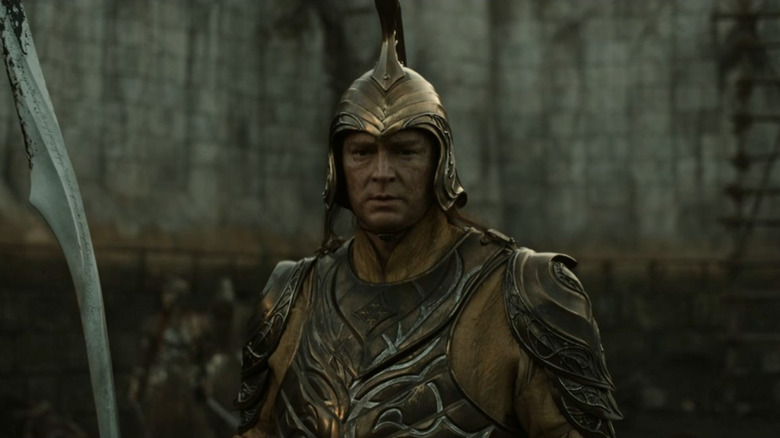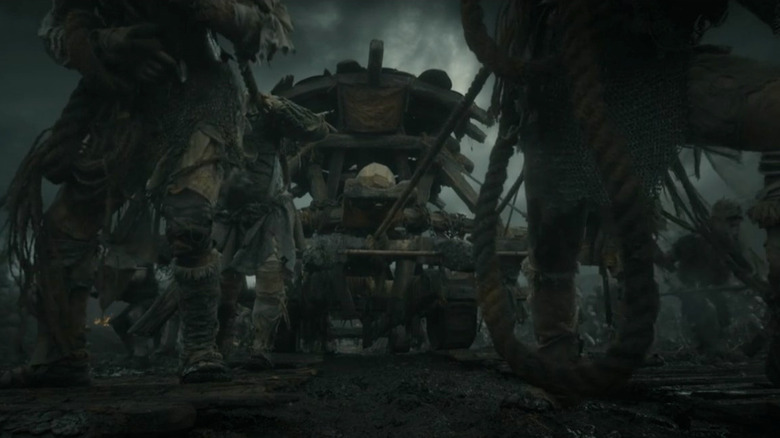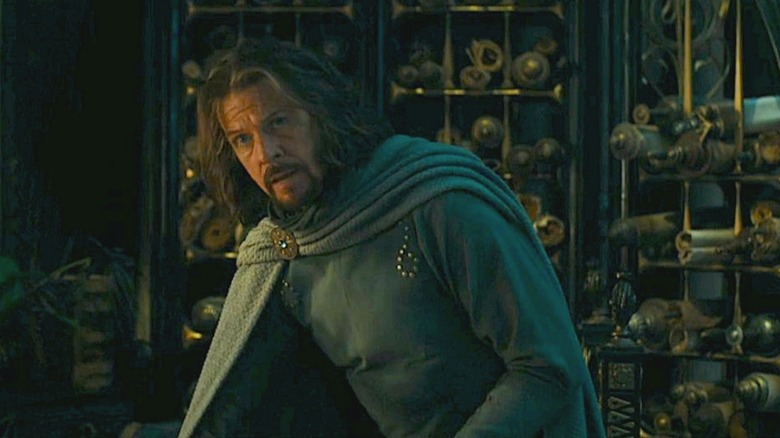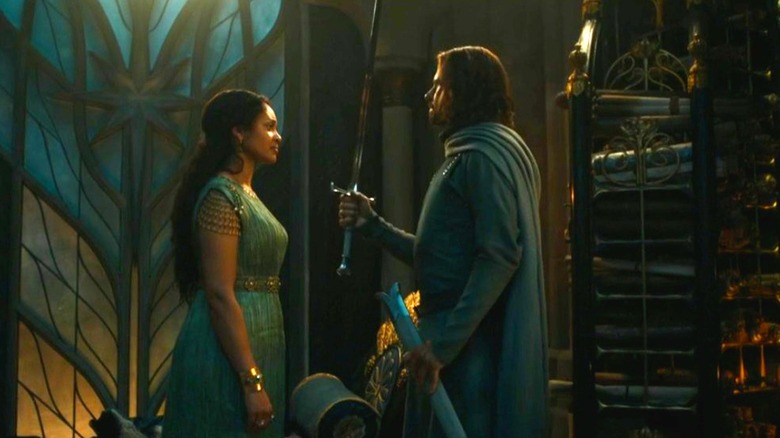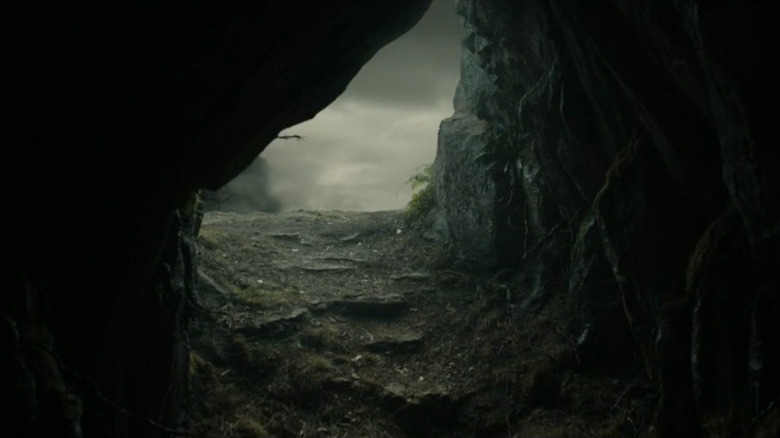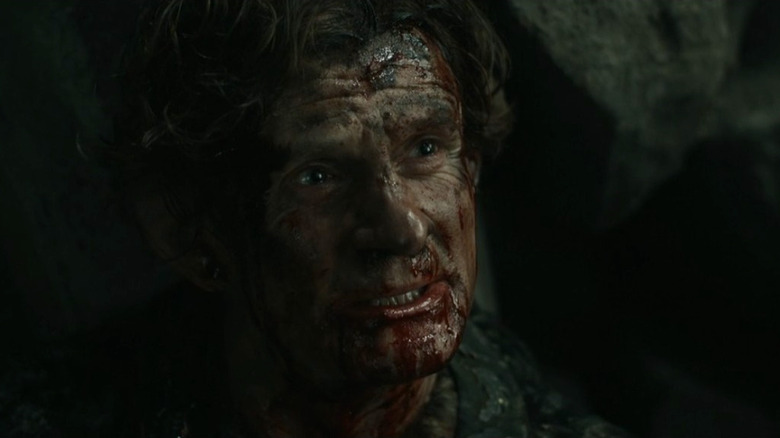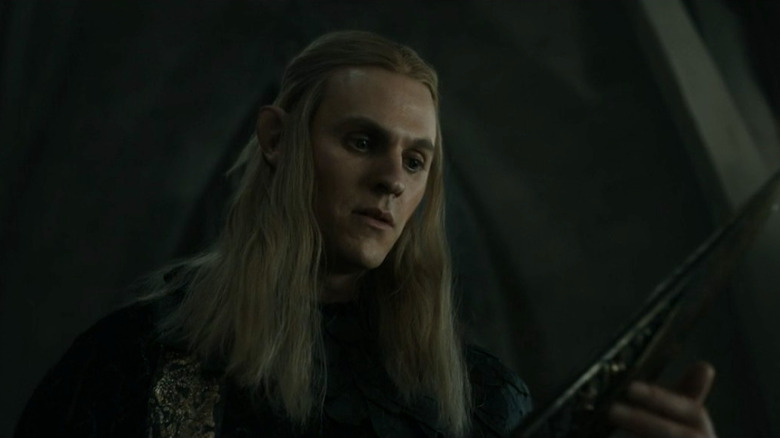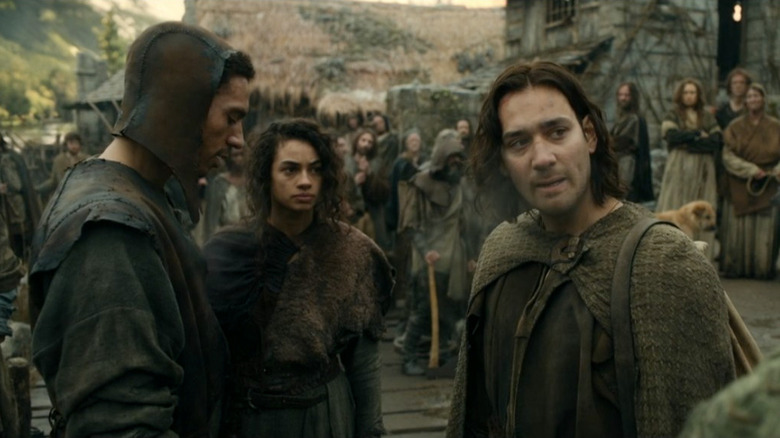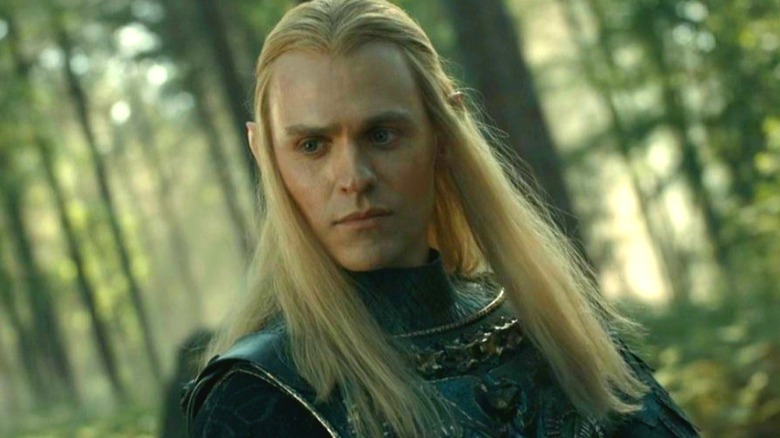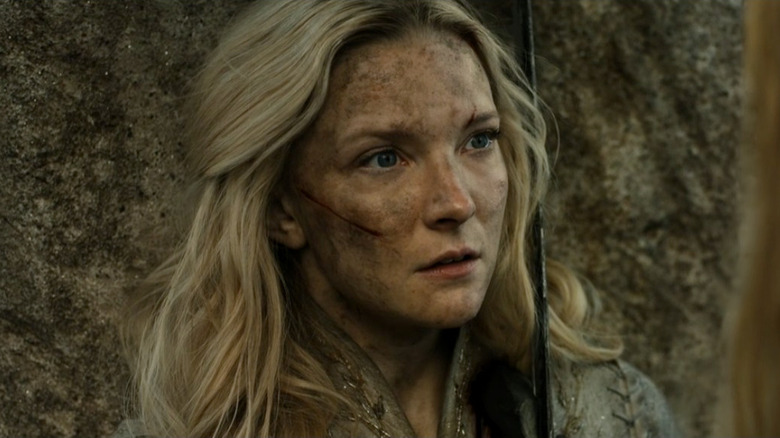Every Easter Egg In The Lord Of The Rings: The Rings Of Power Season 2
Fair warning: This is an intensely detailed piece with a ridiculous number of source material-based spoilers, both for "The Rings of Power" season 2 and for the show and story as a whole. Proceed with caution!
It's a relief to report that, after a wobbly season 1, "The Rings of Power" season 2 raises the stakes in Second Age Middle-earth in every way. The second installment of JD Payne and Patrick McKay's "Lord of the Rings" show features an expanded cast, better writing, and the exploration of all-new areas of Middle-earth. As the showrunners' massive mapped-out five-season story continues to unfold, it has also brought a slew of new easter eggs and small "blink-and-you'll-miss-it" details with it.
As a fan of Tolkien's writings (who has unashamedly read "The Lord of the Rings" over 75 times, "The Hobbit" over 50 times, and "The Silmarillion" over 25 times), this is the really fun part of a show like this. It's the secret, often unspoken language that the cast and crew can use to communicate directly with diehard fans.
These are the details that jump out at me every few seconds as I'm watching. Even more of them pop up on a second viewing. Here they are, presented roughly in chronological order, along with a brief explanation for why they are significant. (This is an ongoing list that will continue to grow until we reach the finale.)
The shadow taking shape again
The season opens up with a flashback of Sauron (in an older form and played by actor Jack Lowden) speaking to a room full of disgruntled Orcs. As he makes his bid to become the new Dark Lord, Sauron says, "Always after a defeat, the shadow takes another shape and grows again." In context, this presumably refers to Sauron wanting to take Morgoth's place as the top baddie in Middle-earth. However, the line is also lifted almost word for word from something Gandalf says in "The Fellowship of the Ring" book (one of the few Tolkienian texts that "The Rings of Power" can adapt).
In that 20th century tome, the Wizard explains to Frodo, "Always after a defeat and a respite, the Shadow takes another shape and grows again." In the book context, this refers to Sauron's resurgence in the lead up to "The Lord of the Rings." The meaning is different in that sense, but it still carries the same foreboding weight in both instances (even if this new, reworked version technically comes right before Sauron is murdered by his own followers and has to take a new shape yet again).
Morgoth is gone and we are disgraced
The other easter egg in this season-opening monologue comes when Sauron says, "Morgoth is gone, leaving us alone and disgraced." As the credit clarifies shortly after this, the scene takes place at the "Dawn of the Second Age." That means Middle-earth has just suffered from the world-shattering War of Wrath, which occurs at the end of the First Age and leads to the downfall of the original Dark Lord, Morgoth.
"The Silmarillion" explains that in that transition, Sauron almost repents of his evil ways, but the book adds, "Then Sauron was ashamed, and he was unwilling to return in humiliation and to receive from the Valar a sentence, it might be, of long servitude in proof of his good faith; for under Morgoth his power had been great." There's your explanation for the words "alone and disgraced." We're seeing the fallout of the cataclysmic ending of original evil in Middle-earth, and right out of the gate, Sauron is already using the emotional weight of recent events to manipulate others to his will. It's a pattern that will continue. (See: The Akallabêth.)
Escaping across the sea
When Sauron, re-embodied in his Halbrand form (Charlie Vickers), stumbles across a group of human refugees in episode 1, a kind old man sparks hope in him again. The man explains where his group is trying to travel, saying, "They say there's places across the sea a man can escape himself."
This one was puzzling for me at first. Going "over the sea" is a very Elvish thing to do in Tolkien's tales, but Men don't do it often — with one exception: Númenor. At the beginning of the Second Age, the god-like Valar raise an island out of the sea and gift it to the faithful Men who fought on the side of good against Morgoth. This becomes Númenor, and "The Silmarillion" explains that the Fathers of Men (basically, that group of good mortals) are led over the sea to the island. This is great for them, but the numerous men they leave behind don't get to come along for the ride. They don't even have that option. Sure, they build coastal towns and ships, but they don't go on migratory sea voyages westward. Instead, Tolkien tells us that "the lot of Men was unhappy" in Middle-earth. It's an interesting twist to have these displaced Men trying to go that direction in the show.
White Towers in Lindon
In episode 1, we see Galadriel (Morfydd Clark) chase Elrond (Robert Aramayo) on horseback as she tries to snatch the Three Rings from Gil-galad's herald. While the action sequence is mostly close up, a couple of the shots sneak above the treeline, and it's possible to see white edifices away in the distance, jutting up from forests and mountain sides.
While we don't know what these are (technically, they're probably some part of Lindon), the presence of white towers in Lindon is actually a book-accurate detail. In fact, there are three towers, in particular, that are called the White Towers. The Prologue to "The Lord of the Rings" describes them thousands of years later thusly: "Three Elf-towers of immemorial age were still to be seen on the Tower Hills beyond the western marches. They shone far off in the moonlight. The tallest was furthest away, standing alone upon a green mound. The Hobbits of the Westfarthing said that one could see the Sea from the top of that tower; but no Hobbit had ever been known to climb it."
The White Towers come up repeatedly throughout the trilogy, too. Sam references them early on as a mystical structure at the vague geographic edges of the Shire. They are brought up as a place of residual Elvish power at the Council of Elrond, too. At the end of the story, Frodo and Bilbo pass them on their way to the Grey Havens, and an elderly Sam eventually says goodbye to his daughter, Elanor, near them decades later. The Towers also play a role in the Second Age fighting, but that's a spoiler that we'll leave for another day and a later season of the show.
Sauron's fair form
When Galadriel reports who Halbrand really is, she says that he is not a man, adding, "He has been masquerading as one, appearing in fair form to hide his true self. He is Sauron." The reference to "fair form" is once again a concept that comes directly from Tolkien himself.
"The Silmarillion" describes Sauron's ability to take on many forms. At one point, it says, "Sauron put on his fair hue again." Shortly after, it says, "and his hue was still that of one both fair and wise."
This is a bigger deal in Tolkien's world than in shapeshifting scenarios in other IPs. It isn't the same as Mystique from the X-Men or the Metamorphmagus ability from Harry Potter. Tolkien's shapeshifting is often laborious, and those who have the ability can lose it over time. In fact, the next time Sauron loses his body in the Second Age, "The Silmarillion" says, "he brooded in the dark, until he had wrought for himself a new shape; and it was terrible, for his fair semblance had departed for ever." Where and why that transformation happens we'll leave for another day, but suffice it to say that Sauron taking a "fair" form is an important easter egg that indicates he's still able to do so at this point in the story. It's a skill that won't last the test of time.
Sauron didn't touch the Elven-rings: Retconning or clarifying?
One of the biggest issues with season 1 of "The Rings of Power" is that it changed the Tolkien Timeline. Not only did the writers have Celebrimbor (Charles Edwards) forge the Three Rings for the Elven-kings first (they should come last, just before the One Ring), but they were made with Sauron's help.
In contrast, in "The Fellowship of the Ring" book, Elrond explicitly states, "The Three were not made by Sauron, nor did he ever touch them." Season 2 of the show addressed this apparent inconsistency immediately and more than once. Less than halfway into episode 1, Galadriel tells Gil-galad regarding Sauron and the Three, "He never touched them, High-king." A while later, Círdan (Ben Daniels) reminds the audience of this season 2 clarification by repeating this crucial little factoid.
It's difficult to tell if this is the show course correcting or if it was a planned reveal all along. Either way, it's left me wondering one crucial thing. By the end of episode 3, we see Sauron quietly cursing the ingredients as they're added to make new Rings of Power. We also see Halbrand clearly touching the mithril used in the Three at the end of season 1. If handling the metallic ingredients is all it takes, Sauron clearly touched the Three. It's a head scratcher, but either way, the show is clearly signaling (in hints and riddles) that the Three Rings are supposed to be unsullied by Sauron.
Círdan: The oldest, wisest, and only bearded Elf
In episode 1, Elrond pays an unexpected visit to the greatest ship builder in Middle-earth, Círdan. When he reveals himself, Elrond requests his help, saying, "You are the oldest and wisest of our kind." This is no joke. While it's difficult to claim to be the oldest of an immortal race, let's just say that Círdan is legitimately one of the oldest Elves alive on the Middle-earth continent.
In fact, Círdan is so old that, according to Tolkien, he's able to grow some whiskers. That's right, Tolkien himself explained why Círdan is the only elf in "The Lord of the Rings" with a beard, saying, "Elves did not have beards until they entered their third cycle of life." While there is one exception to this rule (which we won't go into here), the fact that Círdan has a silver-gray beard makes him uniquely elderly, even among the Elves. The question is, why does he shave it off like three minutes later in the show? Why not rock a beard when you're the only one of your kind within a thousand miles who can do so?
A trollish punishment
In episode 1, a frustrated Gil-galad tells Galadriel, "I should have you thrown in fetters and cast to the Ettenmoors for what you've done." The high-king is understandably perturbed by Galadriel's bungling of the whole Sauron situation, but does the punishment fit the crime? I'd say yes.
According to "The Lord of the Rings: A Reader's Companion," the Ettenmoors consists of the root words "etten" and "moors," which roughly translate as "giant, troll" and "high barren land." Another name for the area in Tolkien's mythology is the troll-fells. This is the region where Bilbo runs into the three hungry trolls. It's also the difficult terrain where Aragorn leads an injured Frodo and his companions in their race to Rivendell when they're pursued by Black Riders.
It's no Mordor, but the area is relatively barren and a difficult place to survive. Even Aragorn sounds reluctant when he talks about the difficulty of potentially stopping to hunt for food. The presence of trolls doesn't make it easier, either. Let's just say, Galadriel messed things up with the Sauron situation in season 1, and Gil-galad's proffered punishment isn't much of an overreaction.
Círdan's proud papa moment
When Elrond shows Círdan the Three Rings in episode 1 and says he doesn't want to save the Elves with them if it means falling prey to the designs of the enemy, Círdan smiles and says, "You do your father proud." This would be true for most dads, but with Elrond the bar is set high — like, really high. How high? Try the stars.
Elrond's dad is the part-Elven, part-Human hero Eärendil, who saves both of his peoples from Morgoth at the end of the First Age by making the impossible voyage West to the Undying Lands to ask for help from the Guardians of Middle-earth called the Valar. After that, Eärendil is tasked with sailing the skies in his vessel with a hallowed gem called a Silmaril bound to his brow, shining like a star amidst the heavens.
This is Elrond's pedigree. This is what he has to live up to (not to mention a slew of other famous relatives). The fact that the oldest Elf in Middle-earth says he would make his father proud isn't some passing statement — it's a loaded one dripping with deeper meaning.
Throwing the Three Rings into the battle-scarred ocean
Elrond and Círdan's solution to the Three Rings is to throw them into the ocean. It's a plan with multiple easter eggs. First, Círdan says, "Long ago there was a battle, one whose weapons were the very bones of the continent. Still now at the spot where our bay meets the sea, there remains on the seabed a scar so deep, its end none but Manwë himself knows." This is a reference to a continent-breaking battle early in Middle-earth history when the overpowered spirits Morgoth and the Valar (including their leader, Manwë) fight over Middle-earth, shattering it into continents.
On top of that, the plan to dump the rings into the watery depths comes straight from "The Fellowship of the Ring" book. During the Council of Elrond, one of the main plans discussed is to drop the One Ring into the depths of the sea, where it would presumably be safe. In that case, this idea is rejected as only a partial solution, since the One Ring could still be recovered, as was the case with Gollum. In "The Rings of Power," they go ahead and actually try this plan, but it is stymied by a timely bubble from the depths. It's an interesting twist from the source material, and one that I personally don't think was strictly necessary. But it's still a fun pair of easter eggs, all the same.
The eye on the saddle
When the marauders in Rhûn are first shown spying on The Stranger, Nori, and Poppy in episode 1, one of them mounts a horse and rides away. The back of his saddle, which is clear to see even in the dark, bears a distinct eye symbol — and anyone who knows anything about Middle-earth knows an eye is an important mark.
By the time of "The Lord of the Rings," the Eye symbol represents Sauron. However, including an eye this early in the story has me scratching my head. Sauron doesn't strongly associate himself with the Eye imagery until much later in the story. Either the show is accelerating that connection and indicating that Sauron is already at work in Rhûn, or there is someone else (perhaps a Ciarán Hinds Wizard) who is using a slightly different iteration of the ocular emblem.
Adar's interesting origin
When Adar interrogates Halbrand regarding the whereabouts of Sauron in episode 1, he tries to disarm his captive with a story about his origin. The tale stretches far back to the "eldest of the Elder Days." (He's immortal, remember). He explains that he was chosen along with 12 others to be given a "new birth" at Morgoth's hand. The group is chained to a mountain peak to starve and thirst until Sauron comes and gives them wine.
This is calling back to the dark beginning of the Orcs, a vague part of Tolkien's lore that the professor describes in multiple ways. One of the most popular of these is in "The Silmarillion," where it says that some of the first Elves to ever awaken in Middle-earth are captured by Morgoth. The book adds that these "by slow arts of cruelty were corrupted and enslaved; and thus did Melkor breed the hideous race of the Orcs in envy and mockery of the Elves, of whom they were afterwards the bitterest foes." Adar's tale goes into a bit more detail, but the connection is clear. Perhaps his group of 13 were supposed to be leaders of the rest?
Hidden images in the title sequence
The title sequence for "The Rings of Power" remains similar to season 1 in the sense that we see small, granular particles creating different shapes on a flat surface, all dancing to the epic tune of a Howard Shore-composed intro piece. However, season 2's sequence features several new and important shapes hidden amidst the shifting sands.
The first and most obvious one is Mount Doom, bubbling and belching. This flows out to make nineteen ring-shaped circles. (Rings of Power, anyone?) We also see a crown with seven stars around it. This reminds me of a quote from "The Return of the King" that describes Aragorn's banner at the Battle of the Pelennor Fields, saying it bore a White Tree and "Seven Stars were about it, and a high crown above it, the signs of Elendil that no lord had borne for years beyond count."
After that, we see what looks like an archway (possibly the doors of Durin?) followed by a clear outlined caricature of the Balrog. Next, a fiery eye and the Mordor-shaped symbol of Adar's people followed by the brief glimpse of a sword (Elendil's sword, Narsil?). It's a busy title sequence, and one chock full of rapid-fire details if you look for them.
Seeing that which has not yet come to pass
In episode 2, Galadriel starts seeing visions of the future. When she tells Gil-galad, he says, "You believe the rings have kindled your ability to see that which has not yet come to pass." While this is helpful exposition for what the Rings can do in the show, the line is reminiscent of another bit of dialogue from "The Fellowship of the Ring" book — though, in this case, it has to do with a different magical item.
When Galadriel tells Frodo what her mirror can do, she says, "it shows things that were, and things that are, and things that yet may be." Later, she tells Sam, "The Mirror shows many things, and not all have yet come to pass." I'd wager good money that the show's writing team was utilizing the same Tolkienian sentence structure for Galadriel's mirror when they wrote the line for the rings.
Cutting palms, bleeding hands
The first time we meet the Dark Wizard (played by Ciarán Hinds) in Rhûn in episode 2, he oversees a bloody ceremony where one of his acolytes cuts the palms of another. They let them bleed on the ground for a moment, clearly as part of the process of completing a spell to recall the fallen mystic from season 1.
The hand cutting brings a similar event to mind. In Peter Jackson's "The Two Towers" extended edition, a Dunlending Man is brought before Saruman to swear allegiance to the Wizard. The mortal does so by slashing his palm with a knife and declaring his willingness to die for Saruman. This doesn't have any connection to the source material (where everyone's hands remain slash-free as far as I'm aware), but the "swearing loyalty to a Wizard via hand-gashed blood pacts" callback to Jackson's trilogy is a fun one, all the same. It also adds fuel to the speculative fire that we're looking at a Saruman/Gandalf showdown in Rhûn — which isn't a good thing if, like yours truly, you're rooting for the Istari to be revealed as Tolkien's mysterious Blue Wizards. Still, the next easter egg helps balance the odds back out again...
Secret cults in the East
We knew we would be meeting a Dark Wizard in season 2 thanks to the promotional material. In episode 2, we finally see Hinds' Wizard in all his discomforting glory as he presides over his cult-like collection of acolytes in a creepy structure that looks like it belongs on Tatooine. While the specifics of the cult worship are made up for the show, the presence of Wizard-led cults in Rhûn does come straight from Tolkien.
The author was famously uncertain about who his Blue Wizards were and what role they played in Middle-earth. Toward the end of his life, he wrote that they were critical forces for good in the fight against Sauron in the East. However, before that, he had a more sobering perspective. In a letter written in 1958, he went so far as to say of their activity in the East, "What success they had I do not know; but I fear that they failed, as Saruman did, though doubtless in different ways; and I suspect they were founders or beginners of secret cults and 'magic' traditions that outlasted the fall of Sauron." See what I mean? A Wizard leading a magic cult in Rhûn is right on point, especially for a Blue Wizard — even if the setting does feel a little bit like it's happening in a galaxy far, far away.
Fredegar ... the Wizard?
The "who is The Stranger" mystery box continues in season 2. (It should come as no surprise that this is to my great chagrin. Just tell us, already! Tolkien didn't write mysteries. He wrote epic journeys where you already know the players as the story unfolds. OK, I'll get off my soapbox.) Yes, we know that Daniel Weyman's character is an Istar now. But other than his magical categorization, we don't know which Wizard he is. Nori doesn't, either, and in episode 2, she tries to come up with names for him, including Fredegar and Doderic.
While Daniel Weyman's character rejects these titles, since they don't make his heart glow, they are real names from Tolkien's canon — and they're Hobbit names, too, which jives with Nori's proto-Hobbit background. Fredegar is an easy connection. In "The Lord of the Rings" books, Fredegar Bolger is the name of the fifth Hobbit companion who helps Frodo by staying behind in the Shire to hide the fact that he's left. Doderic is less obvious, but there is a Hobbit named Doderic Brandybuck who is mentioned in the appendices of "The Return of the King."
Halflings: The hiding experts
When the marauding Wizard minions first try to attack The Stranger and the Harfoots, the latter scamper out of sight. The Stranger hides rather clumsily, but the Harfoots tuck themselves away with the adeptness of, well, Hobbits. On the second page of "The Hobbit," Tolkien literally states, "There is little or no magic about [Hobbits], except the ordinary everyday sort which helps them to disappear quietly and quickly when large stupid folk like you and me come blundering along."
This becomes an even better easter egg when one considers that Nori and Poppy hide under a blanket, which looks from the outside a lot like one of the nearby rocks. This is another clear callback, this time to the Peter Jackson' trilogy. In "The Two Towers," Frodo and Sam hide beneath the Elven cloak, which blends in with the rocks helping them avoid detection.
Now, I have to add here that "The Hobbit" book also says that Hobbits can detect when the Big Folk are "making a noise like elephants which they can hear a mile off." This is ironic, since in the scene in episode 2, The Stranger is the one who hears their enemies' horses approaching. You can't win 'em all, right?
Disa's clever vernacular
Princess Disa (Sophia Nomvete) loves a witty retort. She's always using some obscure or clever phrase to express surprise or comment on a foolish act. These are often connected to geographic things in and around Khazad-dûm, too, which is extra fun if you have a working knowledge of the local geography.
For instance, at one point, Disa says "who in the Dimrill Dale ..." The Dimrill Dale is the valley at the eastern entrance to Khazad-dûm (near to the Bridge of Khazad-dûm). At another point, she references the peak of Zirakzigil. This is one of the three mountains that Khazad-dûm exists beneath. If all of the mountains of Middle-earth blend together for you after a while, I get it. But this one's easy to remember. It's the same mountain peak where Gandalf fights and kills the Balrog several thousand years in the future.
Referencing ancient Elvish bards
In episode 2, when Elrond and Círdan discuss condemning artists compared to condemning their works, Círdan specifically references two famous Elves, Rúmil and Daeron. Not surprisingly, both are real members of Tolkien's canon.
Rúmil is an early creation of the author, who functioned as a loremaster in the earlier drafts of "The Silmarillion," called the "Book of Lost Tales." Daeron is similarly well renowned. In fact, "The Silmarillion" describes him like this: "He became the greatest of all the minstrels of the Elves east of the Sea." While these are excellent examples of great artists, though, I couldn't find anything in my research that shows Tolkien ever described them as drunkards. Sure, Elves drank and were known to get drunk at times, but painting Rúmil and Daeron as raging drunkards is an interesting besmirching of two of the greatest creators in Middle-earth. Artistic license at its finest, right there.
Dragging The Stranger ... again
Harfoots are small. They're petite. And yet, now we've seen two of their young women have to drag a giant Wizard extensive distances, not once, but twice. In episode 2 of season 2, Nori and Poppy find themselves dragging The Stranger on a blanket through the dry, barren sands of Rhûn.
Ironically, in episode 2 of season 1, they did a similar thing. After the unexpected Istar falls from the sky, the two girls gathered him up and escorted him to a little ad hoc bower under a wood. To get him there, they bundled him into a wheelchair device, which they nearly lost control of while navigating a hill. Both scenarios feature extensive complaining from Poppy, too. It's fun to see the show already including easter eggs referencing its own scenes from one season to the next.
Talking without moving a mouth
When Sauron reveals himself to Celebrimbor at the end of episode 2, we get an almost messianic depiction of the Maiar, standing in the midst of a fire in his fair form as Annatar, Lord of Gifts. As he talks, if you look closely, Sauron doesn't move his mouth. He is communicating directly with Celebrimbor without uttering a sound.
This harkens back to an interesting description in "The Return of the King" book, where Tolkien explains this telepathic phenomenon in a surprising amount of detail (for an author who doesn't go into magical or supernatural descriptions much). At one point, Celeborn, Galadriel, Gandalf, and Elrond spend lengthy periods of time conversing in thought only. The text explains, "If any wanderer had chanced to pass, little would he have seen or heard, and it would have seemed to him only that he saw grey figures, carved in stone, memorials of forgotten things now lost in unpeopled lands." Then we get a tiny glimpse into what telepathy looks like in Middle-earth as it says, "For they did not move or speak with mouth, looking from mind to mind; and only their shining eyes stirred and kindled as their thoughts went to and fro." Fun stuff, and it's cool to see the concept reflected in the show, albeit in a much more sinister setting.
An orc wide awake and glaring
When Isildur (Maxim Baldry) wakes up in Shelob's lair at the beginning of episode 3, he isn't alone. Along with his horse, Berek, and an army of baby spiders (who happen to hatch just in time for him to get out alive — thanks for waiting, guys!), Isildur also finds himself grappling with a captured Orc. The fight abruptly and morbidly ends when the latter's head is popped by Shelob from behind. But it's the initial encounter that I want to talk about here, as it is reminiscent of a description we get in "The Two Towers" regarding an Orc that Shelob captures thousands of years later.
In that book, an Orc captain recounts when he and his companions discovered their fellow soldier tied up in the monster's cavernous home. He says, "D'you remember old Ufthak? We lost him for days. Then we found him in a corner; hanging up he was, but he was wide awake and glaring. How we laughed! She'd forgotten him, maybe, but we didn't touch him — no good interfering with Her."
The Orc in Shelob's lair in "Rings of Power" is similarly awake, glaring, and ready to pounce. Of course, in this case, it gets out and nearly takes out Isildur in the process.
Pharazôn's affectionate (and creepy) touch
In episode 3, we finally get an update on the state of affairs on Númenor after King Tar-Palantir's death and the defeat of the nation's army on the mainland. At one point, Queen Regent Míriel (Cynthia Addai-Robinson) prepares for her coronation and Pharazôn (Trystan Gravelle) helps her choose her dress color. As he holds up different colored cloths to her face, he appears to gently and affectionately stroke her cheek.
The action, if that is indeed what is happening here, is a disturbing one, since these two are first cousins. It could also be an easter egg that points directly to "The Silmarillion." In that book, it says that after Míriel's father died, "Pharazôn took her to wife against her will, doing evil in this and evil also in that the laws of Númenor did not permit the marriage, even in the royal house, of those more nearly akin than cousins in the second degree." Yeah. The perverted usurpation is coming, but that doesn't make it any less gross, and we likely just saw the first signs of it.
Troll munched old bone
When the hill-troll Damrod first appears on the scene in Mordor in season 3, we see him come crashing through Adar's camp. The first thing we see is a close-up of his waist, where a net-like cloth is woven with multiple skulls and bones. The connection of Trolls with bones is a fun reference to a poem in "The Fellowship of the Ring," written and performed by the one and only Samwise Gamgee.
The nifty bit of verse is about a run-in between a troll and a character named Tom (who I personally think is Tom Bombadil, but who is never technically identified). The first few lines read: "Troll sat alone on his seat of stone, And munched and mumbled a bare old bone; For many a year he had gnawed it near, for meat was hard to come by." The rest of the poem centers on the Troll and his gnarly chew toy, which makes the boney connection in "Rings of Power" a perfect way for the strong yet stupid race to enter the story.
A Dead Marshes primer
After Isildur escapes from the clutches of Shelob in episode 3, he rides Berek toward safety. It's a long trip, though, and he needs food and water along the way. At one point, he stops by a still body of disgusting-looking water. Just as he prepares to take a sip, he notices that there is a dead body in the water. He ends up swapping clothes with the corpse and taking its sword, but the easter egg here is in the watery grave bit.
When we first see the body, it is lying submerged in a yellow, almost luminous setting, with sickly pale white skin. This is a clear callback to the Dead Marshes that Frodo, Sam, and Gollum pass through in "The Two Towers." The depressing region is filled with white-looking floating corpses — although in that case, they are actively haunted by ghosts.
An even more interesting connection here is that Isildur will end up at the battle of Dagorlad (not far from where he is in episode 3) at the end of the Second Age, and it's that battle where the dead bodies that inhabit the Dead Marshes are produced. It's an interesting and foreboding scene to have him stumble on a corpse in similar straits this early in the story.
The lines, lyrics, and name of Bombadil
Showrunners Payne and McKay previously reported that as much as a quarter of Tom Bombadil's (Rory Kinnear) lines come straight from the books, and that is on full display in episode 4. As one of Tolkien's weirdest and most beloved characters enters the show's story, he's already singing softly to himself, saying things like "Hey dol! Merry dol! Ring a dong dillo!"
Later in the episode, when The Stranger asks him what he is, he says, "Don't you know my name yet? That's the only answer. Tell me, who are you, alone yourself and nameless? But you are young, and I am old. Eldest, that's what I am." Both the lyrics and lines (and several others that he utters throughout the episode) come straight from Bombadil's dialogue in "The Fellowship of the Ring" book.
There are also points where the show has given him lines spoken by his wife, Goldberry. For instance, when The Stranger chases his wind-blown map off into the distance, we hear Bombadil quietly sing, "Of sun, stars, moon and mist, rain and cloudy weather." That is a verse that Goldberry sings in response to his own song later on during the events of "The Lord of the Rings."
Tom's name is also a factor here — in more ways than one. First, he calls himself Eldest (a canon-accurate name), and he is. At least, he's one of the oldest individuals in Middle-earth (Treebeard is also a contender). As a fun additional easter egg, Bombadil's lamb in the show is named "Iarwain," which is one of his own names in the books. Technically, the full rendition is "Iarwain Ben-adar," which means "Oldest and Fatherless."
Whether it's a witty response, a nonsensical song, a fun title, or a wise word, "The Rings of Power" version of Bombadil is supercharged with lines penned by Tolkien himself — a wise move for one of the most difficult-to-adapt characters in all of the Professor's legendarium.
The wandering hermit
Bombadil is referred to in episode 4 as a hermit by the local folk of Rhûn. Later on, when The Stranger asks Bombadil if he can stop the impending alliance between the Dark Wizard and Sauron, the immortal enigma responds, "Old Tom's a wanderer, not a warrior." These associations with being a hermit and a wanderer are both directly and indirectly related to Tolkien's texts.
The hermit one is easier to explain. At the Council of Elrond in "The Fellowship of the Ring" book, Gandalf talks about how, by that time in Middle-earth history, Bombadil has isolated himself, saying, "He is withdrawn into a little land, within bounds that he has set, though none can see them." Bombadil's existence is always on the edge of the story, and his hermit-like living quarters line up with that role.
The wandering part is a bit harder to deconstruct. Why? Because the books refer to Bombadil as the opposite kind of character. In "The Return of the King," Gandalf compares himself with Tom, saying, "He is a moss-gatherer, and I have been a stone doomed to rolling." The implication, of course, is that Bombadil doesn't travel much, so positioning him as a wanderer in the show is curious. I should add, though, that when Elrond brings him up at his council, he does mention all of the ways he used to be known around Middle-earth. This implies that Tom did get out and about more in the past.
Old Forest references
Everyone likes to point out that Tom Bombadil, in particular, was cut from the Peter Jackson and Ralph Bakshi adaptations of "The Fellowship of the Ring," but the truth is, the entire chunk of the story that surrounds Bombadil was cut, too — including the parts that happen in the Old Forest and the Barrow-downs (more on those ghastly mounds in a minute). The Old Forest is easy to forget. What is it, you ask? It is the wooded area that Frodo and his Hobbit friends pass through right after they leave the Shire. This is where they meet Tom, and "The Rings of Power" references the area not once but twice in episode 4.
The first of these comes when Tom names himself, saying, "back in the Withywindle, folk used to call me Bombadil." The Withywindle is the name of the enchanted river that runs through the Old Forest. All paths in that wood lead to it, and it is the center of life in the area.
The other reference is to an infamous tree that lives by the banks of the Withywindle called Old Man Willow. In "The Fellowship of the Ring" book, Tolkien describes this arboreal being, saying, "his heart was rotten, but his strength was green; and he was cunning, and a master of winds, and his song and thought ran through the woods on both sides of the river. His grey thirsty spirit drew power out of the earth and spread like fine root-threads in the ground, and invisible twig-fingers in the air, til it had under its dominion nearly all the trees of the Forest from the Hedge to the Downs." This being captures the Hobbits as they travel, and it's Tom who shows up, hopping and singing, to save them from its timbered clutches. Sound familiar? In episode 4, we get a similar situation when Bombadil coaxes a tree to release The Stranger. The name of that tree? Old Man Ironwood.
Goldberrry: The kind-of present River-daughter
In "The Fellowship of the Ring" book, Tom brings the Hobbits to his house Underhill in the Old Forest. There, they meet his wife, Goldberry (another awesome character who didn't make the cut for the "Lord of the Rings" movies). Goldberry is called the River-daughter, and she is a water spirit that used to live right in a pool in the Withywindle River. In the book, Tom lyrically explains, "By that pool long ago I found the River-daughter, fair young Goldberry sitting in the rushes. Sweet was her singing then, and her heart was beating!"
Ironically, when Tom and Goldberry first meet, the trouble-making sprite playfully pulls him into the water and nearly drowns him. Ultimately, though, Bombadil wins her over, and they get hitched, creating one of the most eccentric power couples in Middle-earth in the process. Tom serves his wife by gathering water lilies for her and recreating her watery home by keeping them in bowls around her.
In episode 4, Bombadil references gathering lilies, and we hear a female voice singing along with him. When The Stranger asks who's there, he acts like it's no one, but right before that, a vessel next to him moves back and forth involuntarily — presumably moved by the presence of or proximity to the River-daughter. While I'm having trouble figuring out quite what they're doing here, it appears Goldberry does have a role in the show, but in the arid lands of Rhûn, she's staying relatively out of sight.
Another Gandalf hint
The Stranger identity question has dragged on for a season and a half now, and episode 4 has multiple little details that add fuel to the fire. For instance, when the Stoor leader Gundabel (Tanya Moodie) says The Stranger is a "grand Elf," it sounds an awful lot like "Gandalf." Another hint comes when Bombadil says, "Great deeds are left to the hands they were placed in."
This is an inspiring line that immediately calls to mind Gandalf's words in "The Fellowship of the Ring" book and movie alike, where Frodo says he wishes none of this had happened and that he could lay down his divinely appointed task, to which the Wizard replies, "So do all who live to see such times, but that is not for them to decide. All we have to decide is what to do with the time that is given to us."
The number of lines, actions, and other indications pointing toward a Gandalf reveal are piling up at this point. All I can say is that either the showrunners think they are cleverly dotting The Stranger's path with details that end up culminating in the wise Grey Wizard we all know and love, or they're creating a Blue Wizard look-alike who operates, acts, and talks like Gandalf, just in a geographically Eastern setting.
Chilling Barrow-wight details
The Barrow-wights are another element of Bombadil's cut part of "The Lord of the Rings" story. While Tom initially meets Frodo and the Hobbits in the Old Forest and saves them from Old Man Willow, his final interaction with them is in a foggy region called the Barrow-downs, where the enigmatic powerhouse uses his salvific songs to stop a ghoulish barrow-wight from slaughtering the four Hobbits in a ritualistic sacrifice.
While Bombadil doesn't bump into the barrow-wights in "The Rings of Power," the haunted creatures do appear in episode 4 as they attempt to stop Elrond, Galadriel, and their Elvish entourage from passing through their bewitched barrows.
The inclusion of the barrow-wights is more than a single, sinister easter egg, too. During this confrontation, the lyrics that they collectively chant in spin-chilling time come straight from the books. I'm talking about the whispered lines that start, "Cold be hand and heart and bone, and cold be sleep under stone." Yeah, creepy stuff. This is what a barrow-wight chants over Frodo and his friends after it captures them in the books, too.
What's more, the Hobbits escape from that situation when Frodo snatches a nearby sword and uses it to cut off the ghostly creature's hand at the wrist as it slowly wriggles around a corner and inches toward its victims. This image is reflected throughout the barrow-wight sequence in the show, where we see multiple hands reaching out from foggy graves, one of which is cut off at the wrist.
The loremaster speaks
By the time of "The Lord of the Rings," Elrond is numbered amongst the Wise, an elite, somewhat undefined group of individuals who are considered exceptionally full of good advice and knowledge. Galadriel, Círdan, and the Wizards are similarly categorized. In "The Rings of Power," Elrond is still very young for an Elf, and his wisest days lie ahead. Nevertheless, he is already starting to gain a reputation for a guy who knows his stuff, especially when it comes to ancient lore. For instance, in "The Silmarillion," when Sauron (as Annatar) tries to dupe the Elves into forging Rings of Power with him, he refers to Elrond's deep knowledge, saying, "wise in all lore is Master Elrond."
We get a glimpse of this burgeoning wisdom in episode 4. As his Elven detachment is attacked by Barrow-wights, Elrond thinks quickly, ransacks a nearby grave, and then uses its ancient weaponry to defeat the otherworldly monsters. To explain this odd behavior, he says, "According to lore, only the blades with which they were buried will return such creatures to rest." While I won't go into detail about how I think this interpretation of defeating barrow-wights with weapons from their own burial mounds is a bit too literal, I will say that it's fun to see the show positioning Elrond as the wise loremaster that will eventually define his reputation across the continent.
Nameless things in the deeps
Episode 4 is busy. There's even time in between meeting Tom Bombadil, facing barrow-wights, and encountering Ents for Arondir (Ismael Cruz Córdova) and Isildur (Maxim Baldry) to fall into a slog of mud, where they are temporarily eaten by a monstrous serpent. Of course, Arondir flashes his military prowess by cutting his way out of its belly (and even slices off a piece of meat for supper in the process), so everything turns out fine for the waylaid heroes. When Isildur asks what it was that attacked them, though, Arondir's answer is simply, "There are nameless things in the deep places of this world."
This is a direct reference to "The Lord of the Rings." In the movies, Gandalf says something like this when the Fellowship travels through Moria in "The Fellowship of the Ring." The full, original quote from the source material, though, is found in "The Two Towers" book, when the Wizard explains his battle with the Balrog in the depths below the Bridge of Khazad-dûm, saying, "Far, far below the deepest delvings of the Dwarves, the world is gnawed by nameless things. Even Sauron knows them not. They are older than he." This open-ended statement is clearly being put to use in the show, where the creatives are integrating plenty of monstrous elements — including some of their own devising, like this unnamed swamp slug-snake.
Ents and axes
When an Ent and Entwife attack a group of Adar-enslaved Southerners in episode 3, the first thing they do is hurl an axe at them. In episode 4, when Arondir tries to calm the fury of the arboreal guardians, the Entwife asks, "Hast thou ever touched axe to wooded life?" Arondir responds, "To my great pain, I have." This is a reference to season 1, when the captured Elf is forced to cut down a tree that lies in the way of the Orcish tunnels that he and his fellow captives are digging. It's a callback within the show, but the easter egg element here goes deeper.
It should come as no surprise that Ents don't like axes. This is a theme that comes up more than once throughout "The Lord of the Rings." When Gimli asks to start a fire on the eves of Fangorn forest in "The Two Towers" book, Aragorn says, "Remember, it is perilous to cut bough or twig from a living tree in Fangorn." When Treebeard meets Gimli for the first time in person later in that book, his initial reaction is described thusly, "'Hoom, hm! Ah now,' said Treebeard, looking dark-eyed at him. 'A dwarf and an axe-bearer!'" Ents have an obvious aversion to axes, and the show is working that right into the mix.
Galadriel and Adar's lifted Lord of the Rings lines
It's hard to recreate Tolkien's dialogue. Usually, the best moments in any Middle-earth adaptation come when a character is able to speak a line that comes verbatim from the books. Tom Bombadil was one example of this. Episode 4 had two others, too — both of which also contain fun easter eggs.
The first is Galadriel's declaration when she takes on an army of Orcs to ensure Elrond, his Elven warriors, and her Ring of Power can escape. As she faces down her enemies, she declares, "Go back to the Shadow." This is a direct callback to Gandalf's words as he faces down the Balrog in Moria. In "The Fellowship of the Ring" book, he says, "The dark fire will not avail you, flame of Udûn. Go back to the Shadow! You cannot pass."
This isn't the only line in this scene lifted from that book, either. Moments after Galadriel utters the words, she is ripped from her saddle and confronted by Adar. The Orc chieftain quenches Galadriel's fiery arrow and, as his face comes into focus, he says, "Elen síla lúmenn' omentielvo." The words are Elvish for "A star shines on the hour of our meeting," and it is a line that Frodo uses when he runs into some Elves in the Shire at the very beginning of his quest. Season 1 leaned a bit too much on original dialogue for its characters for my taste, so it's fun to see season 2 going back more consistently to the well of Tolkien's direct writings to craft each character's lines.
The friendly Doors of Durin
Everyone remembers the Doors of Durin from Peter Jackson's "The Fellowship of the Ring." In episode 5, we get a reveal that the doors are officially in existence, which is a fun piece of lore. The easter eggs in this scene (there are two) aren't so much the iconic doors or their nighttime reflective Ithildin. (We've seen both before in "The Lord of the Rings.") The easter eggs here are about friends.
The friendship angle is fun, and Tolkien definitely uses it, but "Rings of Power" harps on the importance of friendship relentlessly. Friendship feels like it is prioritized over everything else, and it can get a bit exhausting at times. But there are a couple of friendships that are rooted in the lore and really are fun to watch, including the connection between Narvi and Celebrimbor.
In the door reveal scene, Celebrimbor marks the occasion by saying, "Dwarves and Elves working together. It was said to be impossible. But our cooperation has achieved this wonder. And today, we embark upon a new dream. To enshrine our friendship in stone." After Narvi unveils the doors, he explains, "Behold! The Doors of Durin. The new West-gate of our mountain. Unbreachable, visible only by moonlight, and guarded by a password known only to friends." That last bit about friends hints at the door's fun-loving password, "Mellon," which is Elvish for friend. After this, Celebrimbor pokes fun, saying, "Now take note, smiths. Watch Narvi very closely while he's here, not only because he's a masterful artist. He's also a notorious thief. Do not let any jewels go missing." A jovial Narvi responds, "Aye, well, try checking his pockets." Celebrimbor gets things back on track by saying, "To a lasting friendship between Elves and Dwarves."
This dialogue is directly inspired by Tolkien. In the book "Unfinished Tales," it says that Narvi was a "close friend of Celebrimbor of Eregion" and later says that Celebrimbor enters "into a close relationship with the Dwarves of Khazad-dûm, among whom his greatest friend was Narvi." The interracial bromance between the two artisans is an iconic connection in Second Age Middle-earth and one that was long overdue on the screen.
Men who shine
In episode 5, Annatar (Sauron) really starts to turn up the heat on Celebrimbor to forge rings for Men doomed to die. Celebrimbor pushes back that Men are weak and corrupt, but Annatar's counterpoint is that when darkness falls, there are always some who rise forth and shine. At this point, he names three people: Ëarendil, Tuor, and Beren son of Barahir. Who are these "shining Men"? I'm glad you asked.
All three heroes hail from the First Age of Middle-earth (which isn't too distant history at this point in the story). Ëarendil the Mariner is Elrond's dad. He is part Human and part Elvish. When Morgoth conquers nearly all of Middle-earth toward the end of the age, Ëarendil makes a forbidden voyage to the Undying Lands, where he simultaneously represents Elves and Men and asks for help from the angelic guardians of the world called the Valar. They respond, defeat Morgoth, and set Ëarendil, his ship, and a holy jewel called a silmaril in the skies as a star.
Tuor is Ëarendil's dad. He's a full-blooded human, but his fate takes him to the hidden Elvish city of Gondolin, where he marries its Elvish princess Idril (hence Ëarendil's half-elven status). Tuor does great feats when that city is surprise attacked by Morgoth and helps guide its survivors to safety.
And Beren, son of Barahir? He is the Man in Tolkien's famous epic romance Beren and Lúthien. In that story, Beren falls in love with the half-Elven, half-Maiar (angel) Lúthien, and together, they fight through family, friends, foes, and even death to be together. Their grandchild is Elwing, wife of Ëarendil (Tolkien loves to keep things in the family), and the author personally identified himself and his wife with Beren and Lúthien. If Sauron really wants to convince Celebrimbor to forge some Rings of Power for Men, he picked a good starting lineup to make his case.
Eressëa across the seas
Early in episode 5, we see a shot of a white tower on a mountain surrounded by fog in the midst of the sea as the newly minted Ar-Pharazôn narrates, "Have you ever seen it? Across our western seas. The white tower of Eressëa, the very gateway to the Undying Lands." This is a reference to a special Elven spot just outside of the region of Valinor in the West. In "The Silmarillion," Tolkien translates Tol Eressëa as "The Lonely Isle," and it has an epic backstory. Very early in Middle-earth history, the Valar use the island to ferry the Elves en mass across from Middle-earth to the Undying Lands. After two trips, the island was permanently anchored off the shores of Valinor.
The book adds that when the Valar gift the island of Númenor to Men, they are told not to sail from their new homeland to the immortal shores in the distance. However, "at times, when all the air was clear and the sun was in the east, they would look out and descry far off in the west a city white-shining on the distant shore, and a great harbour and a tower."
This is what Ar-Pharazôn is referencing in the scene. Critically, he bitterly elaborates that he thinks the tower is a jeering tease from the Elves, reminding Men that, no matter how high they climb, they will always have to face death. This is an ominous hint at much darker things to come for Númenor and its king in future seasons of the show, but we'll leave that alone for now since this thing is already spoilery enough as is.
Elendil's vision of Númenor
In episode 3, Elendil tries to grab the palantir and is sent flying. (A bit of an odd reaction, considering the palantir are just Seeing Stones, but we'll roll with it.) In episode 5, the Númenórean nobleman reveals what the stone showed him: A vision of himself lost, riding through a foggy wood away from Númenor's city to an unknown location.
This is a small detail that points toward much bigger things to come. Elendil's role in "The Lord of the Rings" is important. By the end of the Third Age (when "The Lord of the Rings" takes place), he's remembered as an iconic hero of old who founded kingdoms, confronted Sauron, and whose broken sword ultimately cut the One Ring from the Dark Lord's hand. Clearly, we have a long way to go from the deposed ship's captain in season 2 of "The Rings of Power," and the palantiric (is that a word?) vision is starting to set the stage for Elendil's rise to glory.
Elendil surrenders his sword
Elendil is famous in Tolkien's lore as a king with a sword. In fact, it's his very sword, Narsil, that Aragorn eventually has reforged into Anduril, the sword he wields in the War of the Ring. In "The Rings of Power," though, Elendil presumably doesn't have this sword yet. Sure, he has a sword, but no one has said anything about his blade being important or having a name. Of course, if Elendil is going to end up with a mythological sword that lasts for thousands of years and stops demonic warlords in their tracks, he needs a reason to swap out his current equipment — and that reason sneakily takes place in the middle of episode 5.
As Kemen (Leon Wadham) disbands the members of the military who belong to the political faction known as the Faithful and takes their equipment, Elendil arrives on the scene. Disturbed by what he's seeing, he confronts Kemen and his own daughter, Eärien (Ema Horvath). While they put him in his place for the time being, one important development is that Elendil publicly and willingly surrenders his sword before leaving. The man is officially swordless, folks — the perfect setup for him to find a better weapon of choice when the time comes.
The seven Dwarven realms
At the midway point of episode 5, Durin III (Peter Mullan) addresses a group that he refers to as "Emissaries of the seven Dwarven realms." In the scene, he informs the group that he has Rings of Power for their masters, seven kings, but that they come with a price.
This reference to seven Dwarven kingdoms comes straight from Tolkien. The Dwarves have an interesting (and far too complicated to recount fully here) origin story. Basically, there are Seven Fathers of the Dwarves who first "awaken" in four different spots across Middle-earth. Durin I is the most famous of these, and the one who founds Khazad-dûm. However, there are six other Dwarvish groups out there in the wide world, and Tolkien explains in the book "The Peoples of Middle-earth" that "though these four points were far sundered the Dwarves of different kindreds were in communication, and in the early ages often held assemblies of delegates at Mount Gundabad." If you're wondering where Mount Gundabad is, it's at the northern top of the spine of Misty Mountains. I don't think that's where the group gathered in the show (presumably they're in Khazad-dûm), but the fact that Dwarven delegates from seven realms are gathering is spot-on canon.
The Dwarven Rings will end up having an impact, too. "The Silmarillion" explains, "It is said that the foundation of each of the Seven Hoards of the Dwarf-kings of old was a golden ring." Of course, as is always the case with Rings of Power, it's not all good news. The book adds, "but all those hoards long ago were plundered and the Dragons devoured them, and of the Seven Rings some were consumed in fire and some Sauron recovered." So, yeah, things aren't looking great for the Dwarves long-term. All the same, incorporating the seven Dwarven realms is a fun flourish and a great easter egg.
The Unseen world
Partway through episode 5, the Elven smith Mirdania (Amelia Kenworthy) discovers that a Ring of Power has made her invisible. She is also terrified to see a figure with fiery skin in the midst of the ring-induced fog. A bit later, Annatar sits down with her to explain that she saw a bit of the Unseen world. He adds, "In its light, things appear as they truly are. Beings of different shades of light ... and its darkness."
This reference to light and darkness when wearing a ring has several subtle connection points in Tolkien's texts. For instance, when Sam briefly puts on the Ring in "The Two Towers" book, it describes the Orcs in front of him as a "phantom company, grey distorted figures in a mist, only dreams of fear with pale flames in their hands." When Frodo puts on the Ring at Weathertop, it says that in the dim darkness, the Ringwraiths become terribly clear and he can see their ghoulish form beneath their outer black robes. It adds, "In their white faces burned keen and merciless eyes; under their mantles were long grey robes; upon their grey hairs were helms of silver; in their haggard hands were swords of steel."
In contrast to these villainous otherworldly encounters, in "The Fellowship of the Ring" book, when Frodo simply has the Ring in his possession and is wounded by the Witch-king's knife, he looks at an Elf-lord named Glorfindel (who could show up in the show at some point) and sees him as a white light. Later, he tells Gandalf, "I thought that I saw a white figure that shone and did not grow dim like the others. Was that Glorfindel then?" The Wizard replies, "Yes, you saw him for a moment as he is upon the other side: one of the might of the Firstborn." When Annatar references the Unseen world as a place defined by light, he isn't kidding.
A far green country under a swift sunrise
In episode 5, we see a religious ceremony of the Faithful on Númenor. As the scene opens and the group honors their dead, the resident priest says that they will help the souls of the departed find peace "until we meet again in the far green country under a swift sunrise."
This is a take on a line Tolkien wrote to describe Frodo's arrival in the Undying Lands at the end of "The Return of the King." The original version reads: "the grey rain-curtain turned all to silver glass and was rolled back, and he beheld white shores and beyond them a far green country under a swift sunrise." Ian McKellen's Gandalf also says a version of this line in Peter Jackson's "The Return of the King" movie, where the Wizard tells Pippin that death is just another path, adding, "The grey rain-curtain of this world rolls back and all turns to silver glass. And then you see it [...] white shores. And beyond, a far green country under a swift sunrise."
The callback is fun, but I have to nit-pick one thing here. The original version of this line isn't a reference to death. It's what Frodo sees when he reaches the Blessed Realm in the West (an area full of immortal life and a location that, during "The Rings of Power," is just a hop, skip, and a jump across the water from where the ceremony is taking place). It was Jackson's movies that turned the line into a heaven-like afterlife reference, and ironically, "The Rings of Power" seems to have catered to that adapted iteration by connecting the line to a funeral ceremony. I guess that makes this one an easter egg inside of an easter egg.
Who are Celebrimbor's smiths?
Celebrimbor is Middle-earth's greatest artisan during the Second Age. The master craftsman can make Rings of Power and glowing magic inscriptions. He's top dog in his field, but he's not alone. While we've seen them before, and in "The Rings of Power" episode 5 we see a lot more of Celebrimbor's crew in action — and these aren't just pupils or support staff. They're the Gwaith-i-Mírdain.
The title is translated in "The Silmarillion" as the "People of the Jewel-smiths," adding that it is the "name of the fellowship of craftsmen in Eregion, greatest of whom was Celebrimbor son of Curufin." The book adds that this group gladly receives the help of Annatar because they (not just Celebrimbor — Tolkien uses the collective) "desired ever to increase the skill and subtlety of their works. Moreover they were not at peace in their hearts." Along with rings, with Sauron's help, the smiths of Eregion reach all-new heights, becoming the greatest Elvish artisans in their people's history with the one exception of Celebrimbor's grandfather, Fëanor — a fiery, gifted, and out-of-control fellow who is a grumpy bundle of fun that I will not break down in detail here.
Gil-galad Elven armies not alone
Toward the end of episode 5, Elrond arrives in Lindon and informs Gil-galad that all is not well in Eregion. Not by a long shot. Adar's army is on the march, and the Elves must send reinforcements. Gil-galad's response is anything but certain. As he hesitates over the role of Sauron in the midst of the chaos, he adds, "Our armies cannot defeat both Adar and Sauron. Not alone."
The hint "not alone" indicates that the High King of the Noldor is thinking of someone else who could help. This could be a hint that he is considering pulling a Galadriel and calling on Númenor for aid. There are also the Dwarves of Khazad-dûm who could get involved. But the Númenor angle is one that has more easter egg potential. Here's why.
In the source material, the events of "The Rings of Power" play out over 3,500 years. The show has understandably adapted this into a much shorter space for continuity, but in the original version, Gil-galad repeatedly connects with Númenor and even calls on it for aid at one point. In the book "Unfinished Tales," he writes to a Númenórean king named Tar-Meneldur early in the Second Age warning him that "a servant of Morgoth is stirring." "The Silmarillion" adds that when Sauron arises openly in power (a bit further down the road in "The Rings of Power" story), the Elves in Lindon under the High King maintain their power partly because "Gil-galad was aided by the Númenóreans." The specific form that the aid takes we will leave for another day due to spoilers, but suffice it to say that Gil-galad probably has a few options in his mind when it comes to cobbling together coalitions to combat Sauron's rise.
Two Orcs arguing
The first easter egg for episode 6 is a fun callback to "The Return of the King." It comes when Arondir dashes through the woods, looking for Adar's hordes, and stumbles on two bickering Orcs, one bigger and one smaller. The Elf-warden hides as they pass by, arguing as they go. "You shut up," says one. "They'll call us deserters," says the other. The first one quips back, "I don't care what they call us. Anything's better than helping Adar chase a ghost."
The scene closely resembles a sequence in "The Return of the King" when Sam and Frodo hide while two Orcs pass by. One is a big fighter, the other is a smaller tracker, and you guessed it — they're fighting. One of them specifically says he wants to go home. The other says he's useless, and starts criticizing their leaders for mismanagement.
Sound familiar? It's subtle, but the connection is there, and when you see it, it's hard to unsee. The two scenes feels nearly identical, that is, until a third Orc shows up and attacks Arondir from behind. In the books, there are only two Orcs, and one eventually kills the other in a quarrel.
Defiant Rings of Power
In the early minutes of episode 6, Celebrimbor is shown thoughtfully looking at some mithril and saying, "Ye Rings of Men, why do you still defy me? You, who live not, breathe not, possess not mind nor will. What pride is woven in your inmost self, that you resist my hand?" This dialogue with an unfinished piece of jewelry is more than the signs of an Elven smith who is breaking down under mental fatigue. It's also a fun callback to the "personality" of the Rings of Power — especially the One Ring.
At multiple points in the "Lord of the Rings" books and movies, this kind of talk comes up. In "The Fellowship of the Ring" movie, Gandalf reveals that "The Ring has awoken. It's heard its master's call." When Frodo says that Sauron was destroyed, the Ring utters a whispering sound in Black Speech.
In the book version, when Bilbo leaves the Ring to Frodo, he warns him that the Ring has a mind of its own and can shrink or expand unexpectedly, falling off a finger when it seemed to be a good fit before. Gandalf also warns that throwing it away is a bad idea because "these Rings have a way of being found." At one point, he completely humanizes the trinket, saying, "The Ring was trying to get back to its master. It had slipped from Isildur's hand and betrayed him; then when a chance came it caught poor Déagol, and he was murdered; and after that Gollum, and it had devoured him. It could make no further use of him [...] so now, when its master was awake once more and sending out his dark thought from Mirkwood, it abandoned Gollum."
To be clear, I'm not saying the One Ring, or any of the Rings of Power, are full-blown characters or that they chat with people. However, characterizing them as more than inanimate objects by having Celebrimbor speak directly to the material out of frustration is a new take on and a clever callback to a concept that is repeated throughout Tolkien's writings.
Feanor's Silmaril
In episode 6, Annatar leaves Celebrimbor in his forge to go out and take control of Eregion. As he exits the workshop, we get a shot of him greeting the expectant crowd, but blocking part of the shot is a statue of an Elf holding a jewel. That statue is Fëanor, and that jewel is a Silmaril.
What are those, you ask?
For starters, Fëanor is the greatest Elven smith of all time. "The Silmarillion" explains that Fëanor means "Spirit of Fire," and directly states that he is "greatest of the Noldor" (that is, the craft-focused, knowledge-obsessed group of Elves that leads the war against Morgoth in the First Age). Fëanor is the guy who forges three Silmarils (jewels with the unquenchable light of the Two Trees of Valinor). When Morgoth steals these, it sparks an age-defining, continent destroying, history-making war that lasts for centuries (even if Fëanor doesn't). Fëanor also creates the palantir — which are front and center on Númenor in season 2 — and devises an Elvish alphabet called Fëanorian script. Basically, the guy is always creating incredible things.
Oh, and did I mention Fëanor is Celebrimbor's grandfather? When Celebrimbor measures his smithcraft against Fëanor, he's not just comparing himself against his professional peers, he's trying to enhance his family's reputation. Reputation is a double-edged concept here, too. Despite his talents and skills, Fëanor is a bad egg, as his is son, Celebrimbor's dad, Curufin. Both hot-headed individuals cause a lot of tragedy earlier in Middle-earth history. So, Celebrimbor wants to outshine Fëanor's accomplishments while also renouncing his family's past misdeeds. That means, later in the episode, when Sauron references besting Fëanor and says compared to the Rings of Power the Silmarils "will merit little more than a whisper," he's playing on Celebrimbor's deepest ambitions, shame, and desires. It's a lot of hidden backstory for a quick shot of a statue with a jewel.
Morgoth's intimidating crown
Early in episode 6, Adar pulls out Morgoth's crown, intimidating Galadriel in the process. He explains that after the Silmarils were pried from the headpiece, Sauron re-fired it to fit his own head. Not surprisingly, this thing has a ton of unspoken backstory. In "The Silmarillion," we hear about the genesis of this crown when the book says, "Morgoth forged for himself a great crown of Iron, and he called himself King of the World. In token of this he set the Silmarils in his crown."
Where this scene gets interesting is the fact that Adar discusses using it against Sauron again. (He already killed him with it once as we saw in the season's opening sequence.) He suggests combining the power of the crown with the Elven Rings to "truly destroy Sauron forever." This is an odd twist on the lore, if you ask me. The Iron Crown does have power — but it comes from the Silmarils that it holds. Those hallowed jewels are holy and powerful, and "The Silmarillion" says Morgoth's evil hands are burned black by the touch of them, and he is never free of the pain. It adds, "That crown he never took from his head, though its weight became a deadly weariness."
See what I'm saying? The power element of the crown is tied to the Silmarils, and those are gone by the time Adar has it. I'm not sure what the angle is with using the lump of iron after the fact as if it's some sort of supercharged weapon or talisman. On top of that, we actually do know where the crown ended up. "The Silmarillion" says that when Morgoth is defeated by his enemies in the War of Wrath, "his iron crown they beat into a collar for his neck." So... yeah. Looks like this easter egg is more than a fun hint — it's a deliberate change to the canon. Sure, it's a minor detail, but it does reinforce the fact that this show is willing to change up Tolkien's original writings whenever it suits the narrative.
Sauron's lies mirror Galadriel's later temptations
When Adar and Galadriel meet in episode 6, they discuss the temptations of Sauron. Galadriel says that the rising Dark Lord offered her an army. Adar says he offered him children. In the setting, this points to the devious temptation of Sauron to give people what they want in exchange for their loyalty. However, I caught an additional easter egg lying under the surface of the conversation.
In "The Fellowship of the Ring" book, when the group by that same name reaches Lothlórien and meets Galadriel for the first time, they are similarly tempted. Not by Sauron, though — by Galadriel. After this meeting, the different members of the fellowship all discuss how she offered each of them something they deeply desired. Boromir talks of the experience with suspicion, saying, "Maybe it was only a test, and she thought to read our thoughts for her own good purpose; but almost I should have said that she was tempting us, and offering what she pretended to have the power to give."
Of course, by that time and in that setting, Galadriel is a pure and noble Elf-woman helping the Fellowship stay true to their purpose. Sauron is the opposite, using temptation and inner desire to lure people from the straight and narrow path. Still, the two are eerily similar.
The son of Amandil
When Elendil is put on trial in episode 6, he is called the "Son of Amandil." This is a fun easter egg since he's facing Ar-Pharazôn (remember, he's king by now, so we need the "Ar-" on there). Why is that special? Because the new king used to be old friends with Amandil. Yeah, they go way back.
"The Silmarillion" says, "In the days of their youth together Amandil had been dear to Pharazôn and though he was of the Elf-friends he remained in his council until the coming of Sauron." Amandil may be no more than a forebear in the show, but name dropping him in front of his best bud Pharazôn — and when Amandil's son is on trial for resisting Pharazôn's kingship, no less — is a clever setup with lots of additional emotional and relational depth when you realize the easter egg it contains. I wonder what's going through the new king's head when he hears that name and considers his judgment.
Stoors, Smials, and hiding Harfoots
Episode 6 doesn't go east to the lands of Rhûn much. But we do get one scene where Nori and the Stoor leader Gundabale (aka "The Gund") talk about their different Halfling lifestyles. While Harfoots find a new place to live on a monthly basis, the Gund's people dwell in underground homes that they lived in their entire lives.
These holes are called smials, a Tolkien original that "The Return of the King" book translates as "burrow." Thousands of years after "The Rings of Power," the word is still used in The Shire. The best example of this is the ancestral home of Pippin Took's family, a massive tunneled mansion literally called Great Smials. It's interesting to see the show exploring, inventing, and contrasting different kinds of Halfling lifestyles and setting the stage for these different groups to come together into a single Hobbit culture. Integrating the canon-accurate easter egg term "smial" into the mix makes it even more fun.
Lord Belzagar
In season 2, Ar-Pharazôn's top supporter is a fella named Lord Belzagar (played by Will Keen). The counselor is always by his king's elbow, offering devious advice in Wormtongue-like fashion. It's Belzagar who comes up with the idea to serve up first Elendil and then Míriel to a giant sea serpent. While his role as a counselor is interesting, the character is made up for the show — even if his name isn't.
In the books, the character named Belzagar is also a Númenórean, but he has a much bigger part to play in the story. In fact, he's a king of Númenor in his own right (the 18th individual to hold that title, to be exact). The book "Unfinished Tales" explains that he is also known as Tar-Calmacil and he is a great ship captain. He is so powerful that he intimidates Sauron, who withdraws his forces from the coastlands of Middle-earth during his reign.
Tar-Calmacil is also one of the first kings to begin truly pulling away from the old pro-Elven ways, embracing the local Adûnaic tongue of men and orienting his people away from the influence of the distant Undying Lands of Valinor. The book ends his summary by saying, "In the days of Tar-Calmacil the name of the King was first spoken in Adûnaic; and by the King's Men he was called Ar-Belzagar."
Dogs in Middle-earth?
When Celebrimbor first encounters the false reality that Sauron has woven for him, he sees a peaceful Eregion. Everyone is blissfully laughing and enjoying life at its finest. One Elf is even shown walking by a fountain walking a dog. This is a first for Middle-earth adaptations. Do Elves even have dogs? You bet they do.
They aren't talked about much, but Tolkien does touch on the concept that people in Middle-earth, including Elves, use hunting dogs. There's one famous case where a hunting dog is front and center, too. When Tolkien's famous "Silmarillion" power couple Beren and Lúthien take on Morgoth and steal a Silmaril from his Iron Crown, they work with a dog named Huan. And yes, I mean they work together. This isn't a submissive, animalistic, one-sided relationship. The wolfhound is famous for being a smart, powerful beast who willingly helps them. He is loyal to the humanoid people he helps, but he also has his own will and is sentient to the point that he even talks three different times during his life. Ultimately, Huan dies after fulfilling a prophecy that he would kill the greatest wolf that ever lived.
The epic story is fun stuff, and the dog we see in Eregion isn't anything like Huan. But still, his existence is proof that dogs do exist here, and it makes the canine by the fountain a fun callback to its four-legged kind's brightest spot in Tolkien's legendarium.
Wild camera shots
One of the most fun shots in episode 6 (and in all of season 2, really) is at the end when we see Sauron go up on the walls to check out Adar's invading forces. (Right on time, guys. He was waiting for you to show up!) As the Dark Lord looks out over the battlements, the camera leaves his shoulder. A chorus of tense strings builds as the shot pans over Eregion, shoots over the river, and approaches the Orc battle encampment on the far side of the water. As it reaches this, we cut to a series of shots showing the Orcs in action, setting up catapults and generally preparing to assault the city.
The camerawork is clearly a horizontal recreation of a famous vertical shot in Peter Jackson's "The Fellowship of the Ring." In that sequence, the camera pans from the moth-whispering Gandalf atop Saruman's tower of Orthanc, cascading down the sides of the tower and right into a hole in the ground, where we see the bustling caverns beneath Isengard. This is followed by a sequence of shots showing the Orcs busily at work, just like the shot in "Rings of Power."
Body parts on pikes
A lot happens in episode 7. As battle breaks out in Eregion and ring madness consumes Khazad-dûm, it's easy to miss the little details constantly flashing across the screen. Despite the importance of the moment, two of these Easter eggs hint at even more tragic things to come. The first appears as Adar's children make their initial attack on Eregion. In that opening charge, Mirdania (Amelia Kenworthy) sees a siege weapon lumbering toward the walls (which we'll talk more about in a bit). When we get a close-up of it, the first thing we see is a skull on a pike.
The other Easter egg comes 15 minutes later. As Elrond rejects Adar's terms to exchange Nenya for Galadriel, the Orc chieftain says, "Very well. I will meet you [on the battlefield], with her head on a pike."
Why are there so many dead body parts either literally or prophetically on pikes? While this isn't unusual behavior in a medieval-inspired fantasy battlefield setting, this particular use of skewered cranium feels to me like a direct callback to "Unfinished Tales," where it says that (massive spoiler, folks) after Celebrimor dies in the source material, "In black anger [Sauron] turned back to battle; and bearing as a banner Celebrimbor's body hung upon a pole, shot through with Orc-arrows, he turned upon the forces of Elrond." While we don't see this happen in episode 7, the signs are there that something similar could be coming.
Dressing up like Orcs
When Galadriel escapes from the Orc encampment in episode 7, she starts her exit by dressing up in the garb of her captors. This is a move that immediately made me think of "The Return of the King," when Frodo and Sam don Orc gear during their escape from the Tower of Cirith Ungol (after Frodo is captured in the aftermath of his encounter with Shelob). They wear the Orc clothing for a while and even run into a group of traveling Orcs, forcing them to blend in with the crowd for a bit before escaping in the hubbub and resuming their trip to Mordor sans Orc armor.
Galadriel has a similar harrowing moment right before she exits the camp, although in her case, her lack of a proper face-masking helmet means she's identified and only gets away thanks to some timely archery from Arondir. The repurposing of Orc clothing as a disguise is a fun callback to the original trilogy and a bonafide way to escape from the clutches of Middle-earth baddies — even if it all but guarantees a kerfuffle along the way.
Cold Rings of Power
Late in episode 7, Celebrimbor tries to destroy his handiwork by melting the Nine Rings for Mortal Men in a hot fire in his workshop. He pulls them out and finds that they are unsinged. In fact, they aren't even warm. The master craftsman looks amazed and concerned as he realizes that he can't melt these powerful tools so easily.
The quite cool state of the Rings of Power is more than a present problem for Celebrimbor. It's also a direct reference to "The Lord of the Rings," where finding a fire hot enough to melt the One Ring is a major catalyst for the entire story. In the "Fellowship of the Ring" movie (one of the best Middle-earth movies of them all), Gandalf melodramatically pulls the One from Frodo's little fire and gives it to him without concern, casually telling him that, "It's quite cool."
In the book version, the Wizard gives the clarification, "Your small fire, of course, would not melt even ordinary gold. This Ring has already passed through it unscathed, and even unheated. But there is no smith's forge in this Shire that could change it at all. Not even the anvils and furnaces of the Dwarves could do that." He does add the caveat that dragon fire could melt the Rings of Power. But otherwise, you can't casually melt these things. The scene in Celebrimbor's workshop is a fun reminder of that fact.
Chopped off appendages and missing fingers
Episode 7 really took the gruesome factor up a notch. Not only did it hint at body parts on pikes. It also featured the desperate, heroic, and downright nasty self-maiming of Celebrimbor when he uses his ring-cutting tool to chop off his own thumb. Yikes! Just to clarify up-front, this isn't a canon-specific detail. Tolkien did say that Celebrimbor is tortured by Sauron to give him the Rings of Power in the books, but the timeline is very different. In the source material, the Rings are already forged and Sauron is simply attacking Eregion to take them by force.
Despite the inconsistency, there are actually multiple Easter eggs tucked into the finger-chopping sequence. First, there's the obvious one: Frodo is literally called Frodo of the Nine Fingers. Of course, the Ring-bearer loses his finger when Gollum chomps it off at the Cracks of Doom — which, coincidentally, is an event that is directly though distantly related to Celebrimbor's forging of the Nine Rings thousands of years earlier.
However, this isn't the only time someone loses a finger — or, in the case of our second example, an entire handful of them. In "The Silmarillion," the Dark Lord Morgoth chains Celebrimbor's uncle, Maedhros, by the hand to a mountainside. When another Elf hero named Fingon arrives to save him, they can't break the hell-wrought bond. Maedhros begs Fingon to kill him in his misery, but Fingon opts to cut his hand off above the wrist, freeing Maedhros from the manacle and giving him a reputation as a one-handed hero from then on out. When Celebrimbor chops off his finger in "The Rings of Power," he may be maimed, but he's in good company.
An Elven Boromir
As Elrond races around Middle-earth throughout season 2, he has an Elven archer named Rían by his side (a character that Looper exclusively revealed back in July). Played by Selina Lo, Rían's official description reads, "Reputed to be one of the finest archers in Lindon, Rían is one of the members of Elrond's recently formed band of warrior-elves. Her courage, and her aim, will prove invaluable in the fight for Eregion."
This description reads true, that is, until almost an hour into the penultimate episode of the season, when Rían is felled by a hail of arrows. As the music turns epic and Rían's final fiery arrow explodes an Orc siege weapon, we get a shot of her from behind, bristling with arrows sticking out of her abdomen, as she falls to her death — Boromir style.
That's right. This scene is clearly channeling the heroic final moments of Boromir in "The Fellowship of the Ring." From its outnumbered, last stand nature to the fact that the character is filled with arrows before they utter their last breath, this is clearly a callback to Sean Bean's epic exit from the "Lord of the Rings" franchise.
That said, I do have to point out that, while it's an Easter egg, this one doesn't resonate the same way as the original. Honestly, the scene tries to elicit the same feeling we get with Boromir. The music and mood are similar. But with the son of Denethor, well, we actually care about him. We just don't care about Rían's character here. It's not for lack of trying. This is simply the problem with such a massive cast. We don't get enough time with Rían to be invested in who she is. I'll stop there, but suffice it to say, invested or not, this character's death is clearly positioned to be the Elven version of Boromir.
Baruk Khazad!
When Prince Durin rallies the Dwarves of Khazad-dûm to march for Eregion, his stirring speech ends with the crowd shouting "Baruk Khazâd!" over and over again. This sounds like a fun rallying cry for the people of Khazâd-dum made up for the show, but it's actually the first half of a battle cry that Gimli shouts in the books. In "The Two Towers," during the battle of Helm's Deep, Gimli saves Aragorn and Éomer from a surprise attack. The book says, "A small dark figure that none had observed sprang out of the shadows and gave a hoarse shout: Baruk Khazâd! Khazâd ai-mênu! An axe swung and swept back. Two Orcs fell headless. The rest fled."
It's a badass moment, and it features that same Dwarvish chant. The translation of the entire phrase reads, "Axes of the Dwarves! The Dwarves are upon you!" That's a fun battle cry. I only wish the show had included the whole thing. By only repeating the first part, they're basically shouting "Axes of the Dwarves!" over and over again. "The Dwarves are upon you!" spices things up a bit. Still, it's fun that the series got the line in there in some form!
Wartime callbacks
The battle for Eregion in episode 7 is absolutely chock-full of Easter eggs. Everywhere you look, there are little details that summon memories of past adaptations and original Tolkienian tales. Here are just a handful of the biggest ones I noticed.
Sauron takes over command of Eregion from an incapacitated leader in much the same way that Gandalf does of Denethor in "The Return of the King." We also get blaring horns in the nick of time and a cavalry charge from a force relieving a besieged city — even if, unlike the Rohirrim, this time, Elrond's charge is stopped at the last second. (This is one of my top gripes about the entire season, by the way. Let them win their spurs!) During the battle itself, there is also the battering ram, which has Grond-like overtones from "The Return of the King." (Grond is obviously much bigger, but the focus on a single tool of mass destruction is similar.)
As dawn breaks the day after the battle, Elrond tells his soldiers, "The Dwarves! The Dwarves are coming! Look to the north!" While they inexplicably look at the sunrise (i.e. east?), we see a lone horseman silhouetted against the light. This ends up being a wounded horseman reporting that the Dwarves actually aren't coming. In this one scene alone, we have a reference to the eucatastrophic "The Eagles are coming!" mantra that Tolkien goes back to repeatedly in his writings. The lone horseman feels a lot like Gandalf's arrival at the end of Helm's Deep in "The Two Towers" (although that goes very differently), and the wounded horseman has strong Faramir retreating to Minas Tirith vibes from "The Return of the King."
Everywhere you look, showrunners JD Payne and Patrick McKay are busily drawing on the inspiration of the source material and past adaptations to bring this battle to life, and the little details like these prove it.
Elrond's great great grandmother gets a shoutout
When Elrond and Adar face off over the parlay table, Adar tells the half-elven herald, "You have the beauty of your foremother, Melian of the Valar. If even a fragment of her wisdom is in your veins, you must know you cannot defeat me in battle." Grandstanding and monologizing aside, who the heck is Melian? I'm glad you asked.
This show has constantly name-dropped Elrond's father, Eärendil, throughout both of its seasons so far. Heck, there's even a giant statue of the guy towering over Númenor's biggest city. And I get it, he's important. But he's just one of a ton of important people that the half-elven fella is related to. Case in point: Melian is Elrond's great great grandmother and another character in Elrond's impressive family tree that is well worth bringing up.
A couple of things about this mention. First, Melian isn't "of the Valar" in the sense that she isn't actually one of them. She is a Maiar, which is the angelic group of individuals who follow the Valar. (They're all the same beings, but the Valar are the official leaders of the group, and Melian isn't one of them.) Melian falls in love with an elven king named Thingol, and they have a child, Lúthien, who marries a man named Beren (a power couple that Tolkien personally associated with himself and his wife). Beren and Lúthien have a son named Díor whose child is Elwing, wife of Eärendil. It's a lot of names, I know. But my point is that all of these people are important — and the parentless angelic being Melian kicks off the entire affair.
Melian is also important because she introduces an angelic component into Elrond's wild ancestry. She is also known as a particularly wise being. "The Silmarillion" says that Galadriel even spent a long time with Melian and learned much lore and wisdom from her. Melian plays a repeating and important role throughout the First Age of Middle-earth history. Her power even allows her to set an enchanted "net" of sorts around her husband's entire kingdom, making it one of the safest places to be during the period of Morgoth's peak power. Bringing her up in the show is a fun shoutout to an incredible being, and a great way for Adar to make Elrond think twice about his decision.
Gil-galad's spear
We've seen Gil-galad's weapon more than once in the show, but it isn't until episode 7 that we see it unleashed in all of its fury. However, the weapon isn't just a fun break from the Elven preference for a bow and sword when it comes to battlefield weapons. It is also a unique and named weapon that is as famous in Middle-earth lore as Aragorn's sword will be in "The Lord of the Rings."
Gil-galad's spear is called Aeglos, which "The Silmarillion" says translates as "Snow-point." Later, the book adds that Gil-galad wields Aeglos during the War of the Last Alliance (the fight that creates the Dead Marshes and which is depicted in the opening sequence of the "Fellowship of the Ring" movie). The text definitively states that during this campaign, "Against Aeglos the spear of Gil-galad none could stand."
While there's a One-Ring-wielding exception to that statement, we'll leave that for another day. Trust me when I say that when Gil-galad wields this spear, it's terrifying. Aeglos is a big enough deal that, several thousand years later, Elrond is still talking about it at the council named after him. In the "Fellowship of the Ring" book, he says, "I was the herald of Gil-galad and marched with his host. I was at the Battle of Dagorlad before the Black Gate of Mordor, where we had the mastery: for the Spear of Gil-galad and the Sword of Elendil, Aeglos and Narsil, none could withstand." Now, we've seen that spear unveiled in battle — and don't worry. We'll see it again. That pointy tool of destruction has much more to do before this Second Age story wraps up.
Weird (but clever) Orcish siege weapons
During the siege of Eregion, the Orcs roll a big, clunky machine up to the walls. At first glance, this is a battering ram, but when they start using it, it turns out to be a, for lack of a better term, wall deconstructor. You pound some anchors into the wall and then use the fierce tension of the machine to rip the stones from the foundation.
At first, I saw this and thought, what are they trying to pull here? (Besides the stones, obviously.) Is this some random attempt to avoid doing the same battering ram schtick that we always see in a siege? But then I realized that, in its own weird way, this odd contraption is actually a subtle Easter egg. Let me explain.
In "The Hobbit," (which the "The Rings of Power" has permission to adapt) when Bilbo and the Dwarves are captured by Goblins, Tolkien deliberately postures the impish enemies as lovers of machinery. The book says, "Now goblins are cruel, wicked, and bad-hearted. They make no beautiful things, but they make many clever ones." It goes on to list the tools they use, including instruments of torture before adding, "It is not unlikely that they invented some of the machines that have since troubled the world, especially ingenious devices for killing large numbers of people at once, for wheels and engines and explosions always delighted them."
See what I mean? This device falls perfectly in line with the goblin penchant for curious, mischievous, and nasty innovation.
Finally mentioning the other son
In the season 2 finale, things go south fast on Númenor as Ar-Pharazôn locks up his Elf-loving political enemies called the Faithful. Elendil races to Queen Míriel to flee the embroiled city with her, saying, "We must leave for the West. There are Faithful there, my son Anárion amongst them."
This reference to Anárion is the first we've heard of Elendil's other son. Isildur we know well, and Eëarien is a daughter invented for the show, but Anárion is a bonafide Tolkien canon character. He has a major role to play alongside his brother later in the story and a tragic ending, too (as is the case with so many of these characters). Mentioning him before the season wraps up sets the stage for the future — and is a fun easter egg, as well. Lots more to come there. Stay tuned!
Narsil shines bright for Elendil
When Míriel sends Elendil away from the capital without her, she gives him a new sword. This is none other than Narsil, which Elendil translates as "The White Flame." (Swords always have badass names in Middle-earth.) Narsil is the sword, too. It's the blade that is broken cutting the One Ring from Sauron's hand and is later reforged as Aragorn's weapon of choice, Andúril, Flame of the West. (Gotta get that "flame" angle in there.)
While the sword is cool, the scene goes even deeper into homage when Elendil suddenly and dramatically draws the blade from its sheath and holds it, pointing up, between him and Míriel — the same way Aragorn draws out Andúril after Elrond gives it to him in "The Return of the King" movie.
A Gondolin reference and homage
As Sauron tortures Celebrimbor to extract the location of the Nine Rings of Power, he reminds him of the frenzied carnage of Orcs and their blood-hunger in battle. "When Gondolin fell," he recalls, "they say it went on, and on. For weeks." This casual reference is talking about the Fall of Gondolin, one of the most tragic chapters of Tolkien's world and the first Middle-earth story he ever wrote.
The Gondolin theme also comes up in the form of an homage shortly before this, as Galadriel flees the city with some of its refugees. She protects a line of distraught Elves as they navigate a tunnel that leads out of the city. This is the same way that the Elven survivors of Gondolin, led by Elrond's Human grandfather Tuor, escape after the sacking of their city.
Borne by a wind
In episode 8, as Celebrimbor breathes his last, he defies Sauron once more, saying, "But the rings are beyond your reach. As I shall be, ere long. For soon I shall go to the shores of the morning. Borne hence, by a wind that you can never follow!" Awe-inspiring final moments of defiance aside, the scene is also a subtle hint at Sauron's ending in "The Lord of the Rings."
Ironically, Sauron's doom actually is to blow away in the wind, just not in the same pleasant manner Celebrimbor is talking about. "The Return of the King" describes Sauron's last moments in physical form after the One Ring is destroyed, saying, "There rose a huge shape of shadow, impenetrable, lighting-crowned, filling all the sky. Enormous it reared above the world, and stretched out towards them a vast threatening hand, terrible but impotent: for even as it leaned over then, a great wind took it, and it was all blown away, and passed; and then a hush fell."
A hint of necromancy
As Sauron tries to ascertain the location of the Nine Rings by force from his old pal Celebrimbor, the Elven master craftsman says that he's going to die soon and escape from the Dark Lord's clutches, to which Sauron replies, "There are ways of keeping you alive, Mellon. Must I show you my mastery of that craft as well?"
The ominous words "ways of keeping you alive" is a nasty little reference to something Sauron is very good at: necromancy. The dark art of dealing with the dead and extending life are two areas where the villain excels. As far as extending life, one need look no further than the literal Rings of Power to see tools that prolong existence (albeit in horrible ways — see: Gollum). And Sauron's familiarity with death? Well, there's a reason he goes by the name of the Necromancer for part of the Third Age (he's explicitly called that in "The Hobbit" book) before he sheds his cloak of secrecy and sets himself up as Sauron again.
Low men and high men
When Isildur wants to bring Estrid and her betrothed back to Númenor, Kemen tells them that, while there is plenty of room on the ship, there is "No passage for low men." This isn't just a viewpoint of a rich, snobby princeling on a power trip. It is a callback to a viewpoint that the Men of Númenor share for thousands of years — although in the source material, the Men of Middle-earth aren't called low men but rather Wild Men of Darkness.
In "The Two Towers" book, Faramir breaks down the low, middle, and high men hierarchy to Frodo and Sam, saying, "For so we reckon Men in our lore, calling them the High, or Men of the West, which were Númenóreans; and the Middle Peoples, Men of the Twilight, such as are the Rohirrim and their kin that dwell still far in the North; and the Wild, the Men of Darkness." It's a rough life in Middle-earth, and the colonizing nature of Númenor creates a caste system that dictates and categorizes their view of their own kind throughout their history.
As a final note here, Kemen also refers to Pelargir as a "colony of Númenor." This is a major progression in the historic downfall of that island nation. "The Silmarillion" says that as they abandon their friendship with Elves and the Valar, "Thus it came to pass in that time that the Númenóreans first made great settlements upon the west shores of the ancient lands [...] and they desired now wealth and dominion in Middle-earth [...] great harbours and strong towers they made [...] but appeared now rather as lords and masters and gatherers of tribute than as helpers and teachers." The arrival of Kemen is the beginning of a colonizing, elitist avalanche of behavior that will not end well for his people.
The winding road
In the season finale, when Galadriel accuses Sauron of planning all of the chaos from the beginning, the Dark Lord responds, "Please. You think too much of me. The road goes ever winding. Not even I can see all its paths."
This line is a subtle play on words from one of Bilbo's poems, which we can find in "The Fellowship of the Ring" book. The Halfling's lyrics read, "The Road goes ever on and on Down from the door where it began. Now far ahead the Road has gone, And I must follow, if I can, Pursuing it with weary feet, Until it joins some larger way, Where many paths and errands meet. And whither then? I cannot say." In Bilbo's case, the words refer to the unexpected adventures that await those willing to embrace them. In Sauron's case, the words appear to be a reference to his willingness to exploit whatever turns of fortune come his way. Either way, that winding Road goes on.
Worshipping Middle-earth's queen
As Sauron defeats Galadriel in battle, he tells her, "I would have placed a crown upon your head. I would never have rested until all Middle-earth had been brought to its knees to worship the light of its Queen." This is a direct callback to Galadriel's line when Frodo offers her the One Ring.
In "The Fellowship of the Ring" book, Galadriel says, "In place of the Dark Lord you will set up a Queen. And I shall not be dark, but beautiful and terrible as the Morning and the Night! Fair as the Sea and the Sun and the Snow upon the Mountains! Dreadful as the Storm and the Lightning! Stronger than the foundations of the earth. All shall love me and despair!"
The writers are clearly trying to set up Galadriel's motivation for that future showdown with power. It's a fun way to expand on the clear struggle going on in Galadriel's mind over the millennia as she prepares for that test — and it creates a fun easter egg, to boot.
***
That's all for season 2. Thanks for reading, and if you're interested, you can listen to our interview with some of the folks who brought this season to life on this episode of the /Film Daily podcast:
